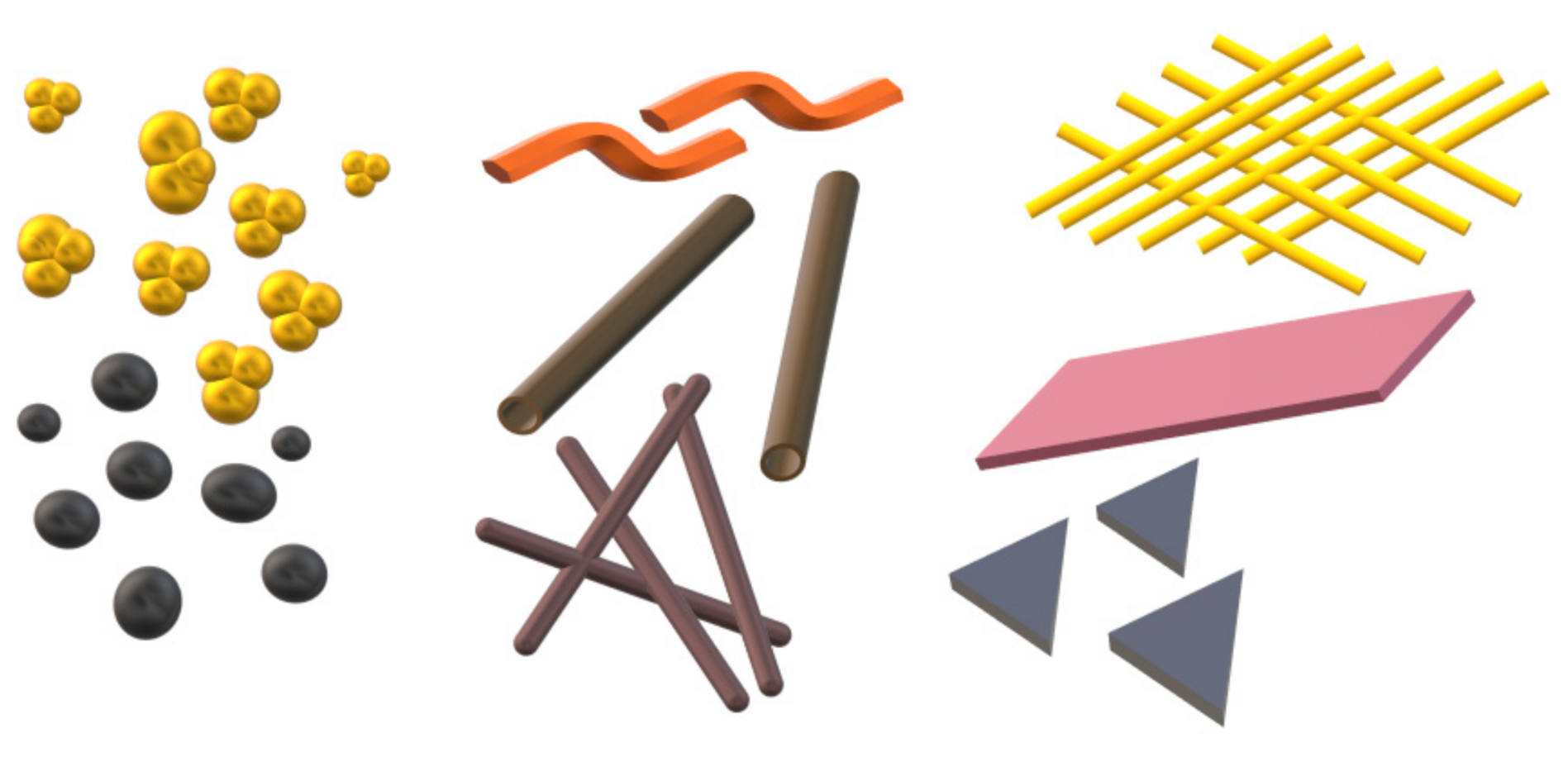A Short Review on Various Engineering Applications of Electrospun One-Dimensional Metal Oxides
Abstract
:1. Introduction
| No. | Project Title | Scientific Unit | Status | Research Object | Ref. |
|---|---|---|---|---|---|
| 1 | The use of collagen for surface functionalization using chemical methods of polycaprolactone nanofibers formed by the electrospinning technique | Institute of Fundamental Technological Research, Polish Academy of Sciences | Current 10 July 2017 09 July 2021 | Manufacturing of three types of nanofibers from various aliphatic polysters—poly (caprolactone), poly (L-lactide) and their copolymer and functionalization of their surface. | [67] |
| 2 | New polymer structures for the construction of photovoltaic cells | University of Silesia in Katowice, Faculty of Science and Technology, Silesian University of Technology, Faculty of Mechanical Engineering | Current 11 October 2017 10 June 2021 | Preparation of composites containing a dispersed phase in the form of a conductive polymer or inorganic ZnO and TiO2 nanoparticles or hybrid systems made of these fillers and optical properties analysis. | [68] |
| 3 | Innovative biocatalytic systems produced by the immobilization of enzymes on multifunctional materials synthesized by electrospinning | Poznan University of Technology, Faculty of Chemical Technology | Current 01 March 2019 28 February 2022 | The use of materials produced by the electrospinning method for the immobilization of selected enzymes of environmental importance and the application of the obtained biocatalytic systems in the processes of dye degradation. | [69] |
| 4 | Multifunctional composite materials enriched with natural polyphenols for potential applications in tissue engineering | AGH University of Science and Technology, Faculty of Materials Science and Ceramics | Current 22 October 2018 21 October 2022 | Design and production of new, multifunctional, bioresorbable composites enriched with polyphenols (PPh) obtained from medicinal plants (sage/rosemary) and individual polyphenolic compounds (rosmarinic acid and carnosic acid). | [70] |
| 5 | Thermosensitive hydrogels filled with bioactive nanofibers for regeneration of neural tissue | Institute of Fundamental Technological Research, Polish Academy of Sciences | Current 21 January 2019 20 January 2022 | Design and manufacturing of a smart, injectable hydrogel, loaded with short electrospun, bioactive PLLA and laminin nanofibers for central nervous system tissue engineering. | [71] |
| 6 | Cellular responses to the properties of electrospun polymer fibers for tissue engineering applications | AGH University of Science and Technology, International Centre of Electron Microscopy for Materials Science | Current 05 February 2020 04 February 2023 | Determining the relationship between the conductive and structural properties of polymer electrospun tissue scaffolds and cell growth for regenerative medicine applications. | [72] |
| 7 | Removal of selected environmental pollutants from water solutions with the use of immobilized laccase | Poznan University of Technology, Faculty of Chemical Technology | Current 20 August 2020 30 September 2021 | Development of a methodology for the production of new carriers in the form of electrospun nanofibers and membranes in the immobilization of enzymes, and then the use of immobilized enzyme systems in the remediation of phenolic compounds from aqueous solutions. | [73] |
| 8 | Nanofibrous mucoadhesive carrier of brinzolamide based on hydroxypropyl cellulose and β-cyclodextrin. | Institute of Fundamental Technological Research, Polish Academy of Sciences | Current 09 July 2020 08 July 2023 | Optimization of the chemical composition and production conditions of a modern nanofiber material intended for the gradual local release of an ophthalmic drug. | [74] |
| 9 | Investigation of the properties of the nature-inspired polymer nanofiber networks in the context of their application for water recovery and energy generation | AGH University of Science and Technology, Faculty of Materials Science and Ceramics | Current 01 September 2016 28 February 2022 | Understanding the process of wetting nanofibers due to their properties and using this knowledge to increase the efficiency of the process of collecting water from the fog, by incorporating nanofibers into the currently used Fog Water Collectors. | [75] |
| 10 | Bioactive materials capable of mimicking the state of hypoxia with high osteogenic and angiogenic potential | Jagiellonian University in Kraków, Faculty of Chemistry | Current 02 October 2019 01 October 2022 | Production of scaffolding containing particles of bioactive glasses modified with transition metal ions by electrospinning. | [76] |
| 11 | Electrical properties and catalytic activity against I-/I3-pair redox reactions of hierarchical carbon nanostructures with a new Ni-Co bimetallic catalyst | AGH University of Science and Technology, Faculty of Materials Science and Ceramics | Current 20 February 2020 19 February 2022 | Synthesis of hierarchical composites based on electrospun carbon nanofibers and metallic nanoparticles and their catalytic properties. | [77] |
2. Electrospinning of Metal Oxides 1D Nanostructures
3. Selected Applications of Electrospun 1D MOS Nanostructures
3.1. Electrospun 1D MOS in Saving the Natural Environment
3.2. Electrospun Metal Oxides 1D Nanostructures in Gas Sensors

| Material Type | Polymer | Precursor | Solvent | Calcination | Gas | Conc [ppm] | Response/Recovery Time [s] | Ref. | |
|---|---|---|---|---|---|---|---|---|---|
| Time [h] | Temp [°C] | ||||||||
| ZnO-SnO2 | PVP | SnCl2·2H2O, Zn(AC)2⋅2H2O | DMF, EtOH | 3 | 600 | Toluene | 1-300 | 6–11/12–23 | [146] |
| NiO-SnO2 | PVP | SnCl2·2H2O, NiCl2·6H2O | DMF, EtOH | 5 | 600 | Toluene | 50 | 11.2/4 | [147] |
| CuO-SnO2 | PVA | SnCl2·2H2O, CuCl2·2H2O | DMF, EtOH | 4 | 600 | H2S | 10 | 1/10 | [148] |
| CeO2-SnO2 | PVP | SnCl2·2H2O, Ce(NO3)3·6H2O | DMF, EtOH | 3 | 600 | EtOH | 200 | 8–10/11–30 | [149] |
| W2O3-SnO2 | PVP | SnCl2·2H2O/ (NH4)6H2W12O40·xH2O | DMF, EtOH | 1 | 600 | EtOH | 10 | 18.5/282 | [150] |
| Fe2O3-In2O3 | PVP | In(NO3)3·4.5H2O, Fe(NO3)3·9H2O | DMF, EtOH | 2 | 550 | Formaldehyde | 100 | 5/25 | [151] |
| WO3-In2O3 | PVP | In(NO3)3·4.5H2O, WCl6 | DMF, EtOH, AcOH | 2 | 500 | Acetone | 25 | 6/64 | [152] |
| CuO-In2O3 | PVP | In(NO3)3·xH2O, Cu(NO3)2·xH2O | DMF | 2 | 600 | H2S | 5 | 4–30/incomplete recovery | [153] |
| SnO2-In2O3 | PVP | In(NO3)3·4.5H2O, SnCl2·2H2O | DMF, EtOH | 2 | 600 | Formaldehyde | 0.5-50 | ~20/40 | [154] |
| In2O3 (RF plasma modified) | PVP | In(NO3)3·4.5H2O | DMF, EtOH | 3 | 550 | Acetone | 10 | 18–23/55–92 | [145] |
| La2O3-In2O3 | PVP | In(NO3)3·xH2O, La(NO3)3·xH2O | DMF, EtOH, mineral oil | 2 | 550 | Formaldehyde | 50 | 3/19 | [155] |
| In2O3 | PVP | In(NO3)3∙4.5 H2O | DMF | 2 | 800 | NO2 | 5 | 200/1000 | [156] |
3.3. Electrospun Metal Oxides 1D Nanostructures in Other Applications
4. Summary and Outlook
Author Contributions
Funding
Institutional Review Board Statement
Informed Consent Statement
Data Availability Statement
Acknowledgments
Conflicts of Interest
References
- Asha, A.B.; Narain, R. Nanomaterials properties. In Polymer Science and Nanotechnology; Elsevier: Amsterdam, The Netherlands, 2020; pp. 343–359. [Google Scholar]
- Wu, Q.; Miao, W.S.; Zhang, Y.D.; Gao, H.J.; Hui, D. Mechanical properties of nanomaterials: A review. Nanotechnol. Rev. 2020, 9, 259–273. [Google Scholar] [CrossRef]
- Baig, N.; Kammakakam, I.; Falath, W.; Kammakakam, I. Nanomaterials: A review of synthesis methods, properties, recent progress, and challenges. Mater. Adv. 2021, 2, 1821–1871. [Google Scholar] [CrossRef]
- Pokropivny, V.V.; Skorokhod, V.V. Classification of nanostructures by dimensionality and concept of surface forms engineering in nanomaterial science. Mater. Sci. Eng. C 2007, 27, 990–993. [Google Scholar] [CrossRef]
- Jeevanandam, J.; Barhoum, A.; Chan, Y.S.; Dufresne, A.; Danquah, M.K. Review on nanoparticles and nanostructured materials: History, sources, toxicity and regulations. Beilstein J. Nanotechnol. 2018, 9, 1050–1074. [Google Scholar] [CrossRef] [PubMed] [Green Version]
- Xia, Y.; Yang, P.; Sun, Y.; Wu, Y.; Mayers, B.; Gates, B.; Yin, Y.; Kim, F.; Yan, H. One-dimensional nanostructures: Synthesis, characterization, and applications. Adv. Mater. 2003, 15, 353–389. [Google Scholar] [CrossRef]
- Yuan, J.; Müller, A.H.E. One-dimensional organic-inorganic hybrid nanomaterials. Polymer 2010, 51, 4015–4036. [Google Scholar] [CrossRef] [Green Version]
- One-Dimensional Nanostructures; Zhai, T.; Yao, J. (Eds.) John Wiley & Sons, Inc.: Hoboken, NJ, USA, 2012; ISBN 9781118310342. [Google Scholar]
- Zhao, X.; Wei, C.-M.; Yang, L.; Chou, M.-Y. Quantum confinement and electronic properties of silicon nanowires. Phys. Rev. Lett. 2004, 92, 236805. [Google Scholar] [CrossRef]
- Matysiak, W.; Tański, T. Novel bimodal ZnO (amorphous)/ZnO NPs (crystalline) electrospun 1D nanostructure and their optical characteristic. Appl. Surf. Sci. 2019, 474, 232–242. [Google Scholar] [CrossRef]
- Matysiak, W.; Tański, T. Analysis of the morphology, structure and optical properties of 1D SiO2 nanostructures obtained with sol-gel and electrospinning methods. Appl. Surf. Sci. 2019, 489, 34–43. [Google Scholar] [CrossRef]
- Kim, J.-H.; Lee, J.-H.; Kim, J.-Y.; Mirzaei, A.; Kim, H.W.; Kim, S.S. Enhancement of CO and NO2 sensing in n-SnO2-p-Cu2O core-shell nanofibers by shell optimization. J. Hazard. Mater. 2019, 376, 68–82. [Google Scholar] [CrossRef]
- Ngoc, T.M.; Van Duy, N.; Duc Hoa, N.; Manh Hung, C.; Nguyen, H.; Van Hieu, N. Effective design and fabrication of low-power-consumption self-heated SnO2 nanowire sensors for reducing gases. Sens. Actuators B Chem. 2019, 295, 144–152. [Google Scholar] [CrossRef]
- Pei, C.C.; Kin Shing Lo, K.; Leung, W.W.F. Titanium-zinc-bismuth oxides-graphene composite nanofibers as high-performance photocatalyst for gas purification. Sep. Purif. Technol. 2017, 184, 205–212. [Google Scholar] [CrossRef]
- Shen, X.-P.; Wu, S.-K.; Zhao, H.; Liu, Q. Synthesis of single-crystalline Bi2O3 nanowires by atmospheric pressure chemical vapor deposition approach. Phys. E Low-Dimens. Syst. Nanostruct. 2007, 39, 133–136. [Google Scholar] [CrossRef]
- Park, Y.-W.; Jung, H.-J.; Yoon, S.-G. Bi2O3 nanowire growth from high-density Bi nanowires grown at a low temperature using aluminum-bismuth co-deposited films. Sens. Actuators B Chem. 2011, 156, 709–714. [Google Scholar] [CrossRef]
- Qiu, Y.; Fan, H.; Chang, X.; Dang, H.; Luo, Q.; Cheng, Z. Novel ultrathin Bi2O3 nanowires for supercapacitor electrode materials with high performance. Appl. Surf. Sci. 2018, 434, 16–20. [Google Scholar] [CrossRef]
- Cao, J.; Dou, H.; Zhang, H.; Mei, H.; Liu, S.; Fei, T.; Wang, R.; Wang, L.; Zhang, T. Controllable synthesis and HCHO-sensing properties of In2O3 micro/nanotubes with different diameters. Sens. Actuators B Chem. 2014, 198, 180–187. [Google Scholar] [CrossRef]
- Lee, C.-S.; Kim, I.-D.; Lee, J.-H. Selective and sensitive detection of trimethylamine using ZnO-In2O3 composite nanofibers. Sens. Actuators B Chem. 2013, 181, 463–470. [Google Scholar] [CrossRef]
- Van Tong, P.; Minh, L.H.; Van Duy, N.; Hung, C.M. Porous In2O3 nanorods fabricated by hydrothermal method for an effective CO gas sensor. Mater. Res. Bull. 2021, 137, 111179. [Google Scholar] [CrossRef]
- Hsu, K.-C.; Fang, T.-H.; Tang, I.-T.; Hsiao, Y.-J.; Chen, C.-Y. Mechanism and characteristics of Au-functionalized SnO2/In2O3 nanofibers for highly sensitive CO detection. J. Alloy. Compd. 2020, 822, 153475. [Google Scholar] [CrossRef]
- Matysiak, W.; Tański, T. Analysis of the morphology, structure and optical properties of SiO2 nanowires obtained by the electrospinning method. In Proceedings of the Materials Today, Milan, Italy, 27–29 June 2018; Elsevier Ltd.: Amsterdam, The Netherlands, 2019; Volume 7, pp. 382–388. [Google Scholar]
- Liu, W.; Xie, Y.; Chen, T.; Lu, Q.; Ur Rehman, S.; Zhu, L. Rationally designed mesoporous In2O3 nanofibers functionalized Pt catalysts for high-performance acetone gas sensors. Sens. Actuators B Chem. 2019, 298, 126871. [Google Scholar] [CrossRef]
- Matysiak, W.; Tański, T.; Smok, W. Study of optical and dielectric constants of hybrid SnO2 electrospun nanostructures. Appl. Phys. A Mater. Sci. Process. 2020, 126, 115. [Google Scholar] [CrossRef] [Green Version]
- Zhou, M.; Liu, Y.; Wu, B.; Zhang, X. Different crystalline phases of aligned TiO2 nanowires and their ethanol gas sensing properties. Phys. E Low-Dimens. Syst. Nanostruct. 2019, 114, 113601. [Google Scholar] [CrossRef]
- Al-Hajji, L.; Ismail, A.A.; Al-Hazza, A.; Ahmed, S.; Alsaidi, M.; Almutawa, F.; Bumajdad, A. Impact of calcination of hydrothermally synthesized TiO2 nanowires on their photocatalytic efficiency. J. Mol. Struct. 2020, 1200, 127153. [Google Scholar] [CrossRef]
- Ramgir, N.; Bhusari, R.; Rawat, N.S.; Patil, S.J.; Debnath, A.K.; Gadkari, S.C.; Muthe, K.P. TiO2/ZnO heterostructure nanowire based NO2 sensor. Mater. Sci. Semicond. Process. 2020, 106, 104770. [Google Scholar] [CrossRef]
- Choi, S.C.; Sohn, S.H. Controllable hydrothermal synthesis of bundled ZnO nanowires using cerium acetate hydrate precursors. Phys. E Low-Dimens. Syst. Nanostruct. 2018, 104, 98–100. [Google Scholar] [CrossRef]
- Wen, S.; Liu, L.; Zhang, L.; Chen, Q.; Zhang, L.; Fong, H. Hierarchical electrospun SiO2 nanofibers containing SiO2 nanoparticles with controllable surface-roughness and/or porosity. Mater. Lett. 2010, 64, 1517–1520. [Google Scholar] [CrossRef]
- Song, B.; Loya, P.; Shen, L.; Sui, C.; He, L.; Guo, H.; Guo, W.; Rodrigues, M.-T.F.; Dong, P.; Wang, C.; et al. Quantitative in situ fracture testing of tin oxide nanowires for lithium ion battery applications. Nano Energy 2018, 53, 277–285. [Google Scholar] [CrossRef]
- Shkurmanov, A.; Sturm, C.; Hochmuth, H.; Grundmann, M. Growth kinetics of ultrathin zno nanowires grown by pulsed laser deposition. Procedia Eng. 2016, 168, 1156–1159. [Google Scholar] [CrossRef]
- Li, H.; Guan, L.; Xu, Z.; Zhao, Y.; Sun, J.; Wu, J.; Xu, N. Synthesis and characterization of amorphous SiO2 nanowires via pulsed laser deposition accompanied by N2 annealing. Appl. Surf. Sci. 2016, 389, 705–712. [Google Scholar] [CrossRef]
- Costa, I.M.; Colmenares, Y.N.; Pizani, P.S.; Leite, E.R.; Chiquito, A.J. Sb doping of VLS synthesized SnO2 nanowires probed by Raman and XPS spectroscopy. Chem. Phys. Lett. 2018, 695, 125–130. [Google Scholar] [CrossRef]
- Chen, Y.; Cui, X.; Zhang, K.; Pan, D.; Zhang, S.; Wang, B.; Hou, J.G. Bulk-quantity synthesis and self-catalytic VLS growth of SnO2 nanowires by lower-temperature evaporation. Chem. Phys. Lett. 2003, 369, 16–20. [Google Scholar] [CrossRef]
- Su, Y.; Liang, X.; Li, S.; Chen, Y.; Zhou, Q.; Yin, S.; Meng, X.; Kong, M. Self-catalytic VLS growth and optical properties of single-crystalline GeO2 nanowire arrays. Mater. Lett. 2008, 62, 1010–1013. [Google Scholar] [CrossRef]
- Hejazi, S.R.; Hosseini, H.R.M.; Ghamsari, M.S. The role of reactants and droplet interfaces on nucleation and growth of ZnO nanorods synthesized by vapor-liquid-solid (VLS) mechanism. J. Alloy. Compd. 2008, 455, 353–357. [Google Scholar] [CrossRef]
- Liu, C.H.; Zapien, J.A.; Yao, Y.; Meng, X.M.; Lee, C.-S.; Fan, S.; Lifshitz, Y.; Lee, S.T. High-density, ordered ultraviolet light-emitting ZnO nanowire arrays. Adv. Mater. 2003, 15, 838–841. [Google Scholar] [CrossRef]
- Wu, G.S.; Xie, T.; Yuan, X.Y.; Li, Y.; Yang, L.; Xiao, Y.H.; Zhang, L.D. Controlled synthesis of ZnO nanowires or nanotubes via sol-gel template process. Solid State Commun. 2005, 134, 485–489. [Google Scholar] [CrossRef]
- Ahmad, N.; Khan, S.; Ansari, M.M.N. Optical, dielectric and magnetic properties of Mn doped SnO2 diluted magnetic semiconductors. Ceram. Int. 2018, 44, 15972–15980. [Google Scholar] [CrossRef]
- Ahmed, A.; Siddique, M.N.; Ali, T.; Tripathi, P. Influence of reduced graphene oxide on structural, optical, thermal and dielectric properties of SnO2 nanoparticles. Adv. Powder Technol. 2018, 29, 3415–3426. [Google Scholar] [CrossRef]
- Wu, J.-J.; Liu, S.-C. Low-temperature growth of well-aligned ZnO nanorods by chemical vapor deposition. Adv. Mater. 2002, 14, 215–218. [Google Scholar] [CrossRef]
- Yildirim, M.A.; Yildirim, S.T.; Sakar, E.F.; Ateş, A. Synthesis, characterization and dielectric properties of SnO2 thin films. Spectrochim. Acta—Part A Mol. Biomol. Spectrosc. 2014, 133, 60–65. [Google Scholar] [CrossRef]
- Varshney, D.; Verma, K. Effect of stirring time on size and dielectric properties of SnO2 nanoparticles prepared by co-precipitation method. J. Mol. Struct. 2013, 1034, 216–222. [Google Scholar] [CrossRef]
- Feng, C.; Liu, X.; Wen, S.; An, Y. Controlled growth and characterization of In2O3 nanowires by chemical vapor deposition. Vacuum 2019, 161, 328–332. [Google Scholar] [CrossRef]
- Tien, L.-C.; Hsieh, Y.-Y. Defect-induced ferromagnetism in undoped In2O3 nanowires. Mater. Res. Bull. 2014, 60, 690–694. [Google Scholar] [CrossRef]
- Wang, T.; Chen, F.; Ji, X.; Zhang, Q. Novel Au-embedded In2O3 nanowire: Synthesis and growth mechanism. Superlattices Microstruct. 2018, 122, 140–146. [Google Scholar] [CrossRef]
- Padmanathan, N.; Shao, H.; McNulty, D.; O’Dwyer, C.; Razeeb, K.M. Hierarchical NiO-In2O3 microflower (3D)/nanorod (1D) hetero-architecture as a supercapattery electrode with excellent cyclic stability. J. Mater. Chem. A 2016, 4, 4820–4830. [Google Scholar] [CrossRef]
- Zhao, Y.; Li, C.; Chen, M.; Yu, X.; Chang, Y.; Chen, A.; Zhu, H.; Tang, Z. Growth of aligned ZnO nanowires via modified atmospheric pressure chemical vapor deposition. Phys. Lett. Sect. Gen. Solid State Phys. 2016, 380, 3993–3997. [Google Scholar] [CrossRef]
- Du, J.; Gu, X.; Guo, H.; Liu, J.; Wu, Q.; Zou, J. Self-induced preparation of TiO2 nanowires by chemical vapor deposition. J. Cryst. Growth 2015, 427, 54–59. [Google Scholar] [CrossRef]
- Fitri, M.A.; Ota, M.; Hirota, Y.; Uchida, Y.; Hara, K.; Ino, D.; Nishiyama, N. Fabrication of TiO2-graphene photocatalyst by direct chemical vapor deposition and its anti-fouling property. Mater. Chem. Phys. 2017, 198, 42–48. [Google Scholar] [CrossRef]
- Kim, H.W.; Myung, J.H.; Shim, S.H. One-dimensional structures of Bi2O3 synthesized via metalorganic chemical vapor deposition process. Solid State Commun. 2006, 137, 196–198. [Google Scholar] [CrossRef]
- Lee, S.-Y.; Lee, H.-R. Field emission from single crystalline tin oxide nanowires synthesized by thermal chemical vapor deposition. Mol. Cryst. Liq. Cryst. 2017, 645, 145–150. [Google Scholar] [CrossRef]
- Jimenez-Cadena, G.; Comini, E.; Ferroni, M.; Vomiero, A.; Sberveglieri, G. Synthesis of different ZnO nanostructures by modified PVD process and potential use for dye-sensitized solar cells. Mater. Chem. Phys. 2010, 124, 694–698. [Google Scholar] [CrossRef] [Green Version]
- Khosravi-Nejad, F.; Teimouri, M.; Jafari Marandi, S.; Shariati, M. The highly crystalline tellurium doped ZnO nanowires photodetector. J. Cryst. Growth 2019, 522, 214–220. [Google Scholar] [CrossRef]
- Serrà, A.; Vallés, E. Advanced electrochemical synthesis of multicomponent metallic nanorods and nanowires: Fundamentals and applications. Appl. Mater. Today 2018, 12, 207–234. [Google Scholar] [CrossRef]
- Jong-hee, P.; Sudarshan, T.S. Chemical Vapor Deposition—Google Books; ASM International: Materials Park, OH, USA, 2001; ISBN 9781615032242. [Google Scholar]
- Redwing, J.M.; Miao, X.; Li, X. Vapor-liquid-solid growth of semiconductor nanowires. In Handbook of Crystal Growth: Thin Films and Epitaxy, 2nd ed.; Elsevier Inc.: Amsterdam, The Netherlands, 2015; Volume 3, pp. 399–439. ISBN 9780444633057. [Google Scholar]
- Liu, Y.; Zhang, K.; Li, M.; Zhao, C.; Wang, X.; Yuan, Z. Ion emission properties of indium nanowires grown on anodic aluminum oxide template. Vacuum 2016, 131, 209–212. [Google Scholar] [CrossRef]
- Matysiak, W.; Tański, T.; Jarka, P.; Nowak, M.; Kępińska, M.; Szperlich, P. Comparison of optical properties of PAN/TiO2, PAN/Bi2O3, and PAN/SbSI nanofibers. Opt. Mater. 2018, 83, 145–151. [Google Scholar] [CrossRef]
- Iqbal, P.; Preece, J.A.; Mendes, P.M. Nanotechnology: The “top-down” and “bottom-up” approaches. In Supramolecular Chemistry; John Wiley & Sons, Ltd.: Hoboken, NJ, USA, 2012. [Google Scholar]
- Sofiah, A.G.N.; Samykano, M.; Kadirgama, K.; Mohan, R.V.; Lah, N.A.C. Metallic nanowires: Mechanical properties—Theory and experiment. Appl. Mater. Today 2018, 11, 320–337. [Google Scholar] [CrossRef]
- McIntyre, P.; Morral, A.F. Semiconductor nanowires: To grow or not to grow? Mater. Today Nano 2019, 9, 100058. [Google Scholar] [CrossRef]
- Domínguez-Adame, F.; Martín-González, M.; Sánchez, D.; Cantarero, A. Nanowires: A route to efficient thermoelectric devices. Phys. E Low-Dimens. Syst. Nanostruct. 2019, 113, 213–225. [Google Scholar] [CrossRef] [Green Version]
- Jarka, P.; Tański, T.; Matysiak, W.; Krzemiński, Ł.; Hajduk, B.; Bilewicz, M. Manufacturing and investigation of surface morphology and optical properties of composite thin films reinforced by TiO2, Bi2O3 and SiO2 nanoparticles. Appl. Surf. Sci. 2017, 424, 206–212. [Google Scholar] [CrossRef]
- Matysiak, W.; Tański, T.; Zaborowska, M. Manufacturing process, characterization and optical investigation of amorphous 1D zinc oxide nanostructures. Appl. Surf. Sci. 2018, 442, 382–389. [Google Scholar] [CrossRef]
- Tański, T.; Jarka, P.; Szindler, M.; Drygała, A.; Matysiak, W.; Libera, M. Study of dye sensitized solar cells photoelectrodes consisting of nanostructures. Appl. Surf. Sci. 2019, 491, 807–813. [Google Scholar] [CrossRef]
- Projekty Finansowane Przez NCN | Narodowe Centrum Nauki. Available online: https://projekty.ncn.gov.pl/index.php?projekt_id=350580 (accessed on 1 September 2021).
- Projekty Finansowane Przez NCN | Narodowe Centrum Nauki. Available online: https://projekty.ncn.gov.pl/index.php?projekt_id=359265 (accessed on 1 September 2021).
- Projekty Finansowane Przez NCN | Narodowe Centrum Nauki. Available online: https://projekty.ncn.gov.pl/index.php?projekt_id=408051 (accessed on 1 September 2021).
- Projekty Finansowane Przez NCN | Narodowe Centrum Nauki. Available online: https://projekty.ncn.gov.pl/index.php?projekt_id=392502 (accessed on 1 September 2021).
- Projekty Finansowane Przez NCN | Narodowe Centrum Nauki. Available online: https://projekty.ncn.gov.pl/index.php?projekt_id=409714 (accessed on 1 September 2021).
- Projekty Finansowane Przez NCN | Narodowe Centrum Nauki. Available online: https://projekty.ncn.gov.pl/index.php?projekt_id=444093 (accessed on 1 September 2021).
- Projekty Finansowane Przez NCN | Narodowe Centrum Nauki. Available online: https://projekty.ncn.gov.pl/index.php?projekt_id=475578 (accessed on 1 September 2021).
- Projekty Finansowane Przez NCN | Narodowe Centrum Nauki. Available online: https://projekty.ncn.gov.pl/index.php?projekt_id=471691 (accessed on 1 September 2021).
- Projekty Finansowane Przez NCN | Narodowe Centrum Nauki. Available online: https://projekty.ncn.gov.pl/index.php?projekt_id=300939 (accessed on 1 September 2021).
- Projekty Finansowane Przez NCN | Narodowe Centrum Nauki. Available online: https://projekty.ncn.gov.pl/index.php?projekt_id=435907 (accessed on 1 September 2021).
- Projekty Finansowane Przez NCN | Narodowe Centrum Nauki. Available online: https://projekty.ncn.gov.pl/index.php?projekt_id=448346 (accessed on 1 September 2021).
- Subbiah, T.; Bhat, G.S.; Tock, R.W.; Parameswaran, S.; Ramkumar, S.S. Electrospinning of nanofibers. J. Appl. Polym. Sci. 2005, 96, 557–569. [Google Scholar] [CrossRef]
- Hohman, M.M.; Shin, M.; Rutledge, G.; Brenner, M.P. Electrospinning and electrically forced jets. I. Stability theory. Phys. Fluids 2001, 13, 2201–2220. [Google Scholar] [CrossRef] [Green Version]
- Yarin, A.L.; Koombhongse, S.; Reneker, D.H. Taylor cone and jetting from liquid droplets in electrospinning of nanofibers. J. Appl. Phys. 2001, 90, 4836–4846. [Google Scholar] [CrossRef] [Green Version]
- Bhardwaj, N.; Kundu, S.C. Electrospinning: A fascinating fiber fabrication technique. Biotechnol. Adv. 2010, 28, 325–347. [Google Scholar] [CrossRef] [PubMed]
- Lewandowska, M.; Kurzydłowski, K. Nanomateriały Inżynierskie Konstrukcyjne i Funkcjonalne; Wydawnictwo Naukowe PWN: Warszawa, Poland, 2010. [Google Scholar]
- Matysiak, W.; Tanski, T.; Smok, W. Electrospinning as a versatile method of composite thin films fabrication for selected applications. Solid State Phenom. 2019, 293, 35–49. [Google Scholar] [CrossRef]
- Tański, T.; Matysiak, W.; Jarka, P. Introductory chapter: Electrospinning-smart nanofiber mats. In Electrospinning Method Used to Create Functional Nanocomposites Films; InTech: London, UK, 2018. [Google Scholar]
- Someswararao, M.V.; Dubey, R.S.; Subbarao, P.S.V.; Singh, S. Electrospinning process parameters dependent investigation of TiO2 nanofibers. Results Phys. 2018, 11, 223–231. [Google Scholar] [CrossRef]
- Wang, T.; Gao, Y.; Tang, T.; Bian, H.; Zhang, Z.; Xu, J.; Xiao, H.; Chu, X. Preparation of ordered TiO2 nanofibers/nanotubes by magnetic field assisted electrospinning and the study of their photocatalytic properties. Ceram. Int. 2019, 45, 14404–14410. [Google Scholar] [CrossRef]
- Di Mauro, A.; Zimbone, M.; Fragalà, M.E.; Impellizzeri, G. Synthesis of ZnO nanofibers by the electrospinning process. Mater. Sci. Semicond. Process. 2016, 42, 98–101. [Google Scholar] [CrossRef]
- Raut, H.K.; Nair, A.S.; Dinachali, S.S.; Ganesh, V.A.; Walsh, T.M.; Ramakrishna, S. Porous SiO2 anti-reflective coatings on large-area substrates by electrospinning and their application to solar modules. Sol. Energy Mater. Sol. Cells 2013, 111, 9–15. [Google Scholar] [CrossRef]
- Ezhilan, M.; JBB, A.J.; Babu, K.J.; Rayappan, J.B.B. Hierarchically connected electrospun WO3 nanowires—An acetaldehyde sensor. J. Alloy. Compd. 2021, 863, 158407. [Google Scholar] [CrossRef]
- Leng, J.Y.; Xu, X.J.; Lv, N.; Fan, H.T.; Zhang, T. Synthesis and gas-sensing characteristics of WO3 nanofibers via electrospinning. J. Colloid Interface Sci. 2011, 356, 54–57. [Google Scholar] [CrossRef]
- Schabikowski, M.; Cichoń, A.; Németh, Z.; Kubiak, W.; Kata, D.; Graule, T. Electrospun iron and copper oxide fibers for virus retention applications. Text. Res. J. 2019, 89, 4373–4382. [Google Scholar] [CrossRef]
- Zhang, Y.; He, J.; Shi, R.; Yang, P. Preparation and photo Fenton-like activities of high crystalline CuO fibers. Appl. Surf. Sci. 2017, 422, 1042–1051. [Google Scholar] [CrossRef]
- Zheng, W.; Li, Z.; Zhang, H.; Wang, W.; Wang, Y.; Wang, C. Electrospinning route for α-Fe2O3 ceramic nanofibers and their gas sensing properties. Mater. Res. Bull. 2009, 44, 1432–1436. [Google Scholar] [CrossRef]
- Liu, C.; Shan, H.; Liu, L.; Li, S.; Li, H. High sensing properties of Ce-doped α-Fe2O3 nanotubes to acetone. Ceram. Int. 2014, 40, 2395–2399. [Google Scholar] [CrossRef]
- Zhang, Y.; He, X.; Li, J.; Miao, Z.; Huang, F. Fabrication and ethanol-sensing properties of micro gas sensor based on electrospun SnO2 nanofibers. Sens. Actuators B Chem. 2008, 132, 67–73. [Google Scholar] [CrossRef]
- Wang, C.; Shao, C.; Wang, L.; Zhang, L.; Li, X.; Liu, Y. Electrospinning preparation, characterization and photocatalytic properties of Bi2O3 nanofibers. J. Colloid Interface Sci. 2009, 333, 242–248. [Google Scholar] [CrossRef] [PubMed]
- Veeralingam, S.; Badhulika, S. Surface functionalized β-Bi2O3 nanofibers based flexible, field-effect transistor-biosensor (BioFET) for rapid, label-free detection of serotonin in biological fluids. Sens. Actuators B Chem. 2020, 321, 128540. [Google Scholar] [CrossRef]
- Liang, X.; Jin, G.; Liu, F.; Zhang, X.; An, S.; Ma, J.; Lu, G. Synthesis of In2O3 hollow nanofibers and their application in highly sensitive detection of acetone. Ceram. Int. 2015, 41, 13780–13787. [Google Scholar] [CrossRef]
- Blachowicz, T.; Ehrmann, A. Recent developments in electrospun ZnO nanofibers: A short review. J. Eng. Fiber. Fabr. 2020, 15. [Google Scholar] [CrossRef] [Green Version]
- Zhu, S.; Nie, L. Progress in fabrication of one-dimensional catalytic materials by electrospinning technology. J. Ind. Eng. Chem. 2021, 93, 28–56. [Google Scholar] [CrossRef]
- Wang, L.; Yang, G.; Peng, S.; Wang, J.; Yan, W.; Ramakrishna, S. One-dimensional nanomaterials toward electrochemical sodium-ion storage applications via electrospinning. Energy Storage Mater. 2019, 25, 443–476. [Google Scholar] [CrossRef]
- Huang, X.; Zhang, M.; Qin, Y.; Chen, Y. Bead-like Co-doped ZnO with improved microwave absorption properties. Ceram. Int. 2019, 45, 7789–7796. [Google Scholar] [CrossRef]
- Zhang, J.; Hou, X.; Pang, Z.; Cai, Y.; Zhou, H.; Lv, P.; Wei, Q. Fabrication of hierarchical TiO2 nanofibers by microemulsion electrospinning for photocatalysis applications. Ceram. Int. 2017, 43, 15911–15917. [Google Scholar] [CrossRef]
- Nasr, M.; Balme, S.; Eid, C.; Habchi, R.; Miele, P.; Bechelany, M. Enhanced visible-light photocatalytic performance of electrospun rGO/TiO2 composite nanofibers. J. Phys. Chem. C 2017, 121, 261–269. [Google Scholar] [CrossRef]
- Boyadjiev, S.I.; Kéri, O.; Bárdos, P.; Firkala, T.; Gáber, F.; Nagy, Z.K.; Baji, Z.; Takács, M.; Szilágyi, I.M. TiO2/ZnO and ZnO/TiO2 core/shell nanofibers prepared by electrospinning and atomic layer deposition for photocatalysis and gas sensing. Appl. Surf. Sci. 2017, 424, 190–197. [Google Scholar] [CrossRef] [Green Version]
- Dursun, S.; Koyuncu, S.N.; Kaya, İ.C.; Kaya, G.G.; Kalem, V.; Akyildiz, H. Production of CuO–WO3 hybrids and their dye removal capacity/performance from wastewater by adsorption/photocatalysis. J. Water Process. Eng. 2020, 36, 101390. [Google Scholar] [CrossRef]
- Soares, L.; Alves, A. Photocatalytic properties of TiO2 and TiO2/WO3 films applied as semiconductors in heterogeneous photocatalysis. Mater. Lett. 2018, 211, 339–342. [Google Scholar] [CrossRef]
- Ch, S.R.; Zhang, L.; Kang, T.; Lin, Y.; Qiu, Y.; Reddy, A.S. Annealing impact on the structural and optical properties of electrospun SnO2 nanofibers for TCOs. Ceram. Int. 2018, 44, 4586–4591. [Google Scholar] [CrossRef]
- Lim, G.-D.; Yoo, J.-H.; Ji, M.; Lee, Y.-I. Visible light driven photocatalytic degradation enhanced by α/β phase heterojunctions on electrospun Bi2O3 nanofibers. J. Alloy. Compd. 2019, 806, 1060–1067. [Google Scholar] [CrossRef]
- Lu, N.; Shao, C.; Li, X.; Miao, F.; Wang, K.; Liu, Y. A facile fabrication of nitrogen-doped electrospun In2O3 nanofibers with improved visible-light photocatalytic activity. Appl. Surf. Sci. 2017, 391, 668–676. [Google Scholar] [CrossRef]
- Wang, Z.; Li, Z.; Zhang, H.; Wang, C. Improved photocatalytic activity of mesoporous ZnO-SnO2 coupled nanofibers. Catal. Commun. 2009, 11, 257–260. [Google Scholar] [CrossRef]
- Zhu, C.; Li, Y.; Su, Q.; Lu, B.; Pan, J.; Zhang, J.; Xie, E.; Lan, W. Electrospinning direct preparation of SnO2/Fe2O3 heterojunction nanotubes as an efficient visible-light photocatalyst. J. Alloy. Compd. 2013, 575, 333–338. [Google Scholar] [CrossRef]
- Zhang, P.; Wang, L.; Zhang, X.; Shao, C.; Hu, J.; Shao, G. SnO2-core carbon-shell composite nanotubes with enhanced photocurrent and photocatalytic performance. Appl. Catal. B Environ. 2015, 166–167, 193–201. [Google Scholar] [CrossRef]
- Wang, K.; Qian, Z.; Guo, W. Multi-heterojunction of SnO2/Bi2O3/BiOI nanofibers: Facile fabrication with enhanced visible-light photocatalytic performance. Mater. Res. Bull. 2019, 111, 202–211. [Google Scholar] [CrossRef]
- Zhang, Q.; Cheah, P.; Han, F.; Dai, Q.; Yan, Y.; Pramanik, A.; Chandra Ray, P. Effects of calcination temperature on crystal structure and photocatalytic activity of CaIn2O4/In2O3 composites. Ceram. Int. 2019, 45, 21851–21857. [Google Scholar] [CrossRef]
- Ahmad, A.; Khan, M.A.; Nazir, A.; Arshad, S.N.; Qadir, M.B.; Khaliq, Z.; Khan, Z.S.; Satti, A.N.; Mushtaq, B.; Shahzad, A. Triaxial electrospun mixed-phased TiO2 nanofiber-in-nanotube structure with enhanced photocatalytic activity. Miroporous Mesoporous Mater. 2021, 320, 111104. [Google Scholar] [CrossRef]
- Mansouri, S.; Abbaspour-Fard, M.H.; Meshkini, A. Lily (Iris Persica) pigments as new sensitizer and TiO2 nanofibers as photoanode electrode in dye sensitized solar cells. Optik 2020, 202, 163710. [Google Scholar] [CrossRef]
- Li, X.; Gao, C.; Wang, J.; Lu, B.; Chen, W.; Song, J.; Zhang, S.; Zhang, Z.; Pan, X.; Xie, E. TiO 2 films with rich bulk oxygen vacancies prepared by electrospinning for dye-sensitized solar cells. J. Power Sources 2012, 214, 244–250. [Google Scholar] [CrossRef]
- Anjusree, G.S.; Deepak, T.G.; Nair, S.V.; Nair, A.S. Facile fabrication of TiO2 nanoparticle-TiO2 nanofiber composites by co-electrospinning-electrospraying for dye-sensitized solar cells. J. Energy Chem. 2015, 24, 762–769. [Google Scholar] [CrossRef]
- Mahmood, K.; Khalid, A.; Ahmad, S.W.; Mehran, M.T. Indium-doped ZnO mesoporous nanofibers as efficient electron transporting materials for perovskite solar cells. Surf. Coat. Technol. 2018, 352, 231–237. [Google Scholar] [CrossRef]
- Dinesh, V.P.; Sriram kumar, R.; Sukhananazerin, A.; Mary Sneha, J.; Manoj Kumar, P.; Biji, P. Novel stainless steel based, eco-friendly dye-sensitized solar cells using electrospun porous ZnO nanofibers. Nano-Struct. Nano-Objects 2019, 19, 100311. [Google Scholar] [CrossRef]
- Mohamed, I.M.A.; Dao, V.-D.; Yasin, A.S.; Choi, H.-S.; Barakat, N.A.M. Synthesis of novel SnO2@TiO2 nanofibers as an efficient photoanode of dye-sensitized solar cells. Int. J. Hydrogen Energy 2016, 41, 10578–10589. [Google Scholar] [CrossRef]
- Bakr, Z.H.; Wali, Q.; Ismail, J.; Elumalai, N.K.; Uddin, A.; Jose, R. Synergistic combination of electronic and electrical properties of SnO2 and TiO2 in a single SnO2-TiO2 composite nanofiber for dye-sensitized solar cells. Electrochim. Acta 2018, 263, 524–532. [Google Scholar] [CrossRef]
- Lim, J.M.; Moon, J.; Kim, J.H.; Lee, C.O.; Chi, W.S.; Park, J.T. One-dimensional SnO2 nanotube solid-state electrolyte for fast electron transport and high light harvesting in solar energy conversion. Solid State Ionics 2021, 363, 115584. [Google Scholar] [CrossRef]
- Wei, K.; Gu, X.Y.; Chen, E.Z.; Wang, Y.Q.; Dai, Z.; Zhu, Z.R.; Kang, S.Q.; Wang, A.C.; Gao, X.P.; Sun, G.Z.; et al. Dissymmetric interface design of SnO2/TiO2 side-by-side bi-component nanofibers as photoanodes for dye sensitized solar cells: Facilitated electron transport and enhanced carrier separation. J. Colloid Interface Sci. 2021, 583, 24–32. [Google Scholar] [CrossRef]
- Matysiak, W.; Tański, T.; Smok, W.; Polischuk, O. Synthesis of hybrid amorphous/crystalline SnO2 1D nanostructures: Investigation of structure, morphology and optical properties. Sci. Rep. 2020, 10, 14802. [Google Scholar] [CrossRef]
- Yang, M.; Li, X.; Yan, B.; Fan, L.; Yu, Z.; Li, D. Reduced graphene oxide decorated porous SnO2 nanotubes with enhanced sodium storage. J. Alloy. Compd. 2017, 710, 323–330. [Google Scholar] [CrossRef]
- Wang, Q.; Bai, J.; Huang, B.; Hu, Q.; Cheng, X.; Li, J.; Xie, E.; Wang, Y.; Pan, X. Design of NiCo2O4@SnO2 heterostructure nanofiber and their low temperature ethanol sensing properties. J. Alloy. Compd. 2019, 791, 1025–1032. [Google Scholar] [CrossRef]
- Righettoni, M.; Amann, A.; Pratsinis, S.E. Breath analysis by nanostructured metal oxides as chemo-resistive gas sensors. Mater. Today 2015, 18, 163–171. [Google Scholar] [CrossRef]
- Güntner, A.T.; Pineau, N.J.; Mochalski, P.; Wiesenhofer, H.; Agapiou, A.; Mayhew, C.A.; Pratsinis, S.E. Sniffing entrapped humans with sensor arrays. Anal. Chem. 2018, 90, 4940–4945. [Google Scholar] [CrossRef] [Green Version]
- Tai, H.; Wang, S.; Duan, Z.; Jiang, Y. Evolution of breath analysis based on humidity and gas sensors: Potential and challenges. Sens. Actuators B Chem. 2020, 318, 128104. [Google Scholar] [CrossRef]
- Bhati, V.S.; Hojamberdiev, M.; Kumar, M. Enhanced sensing performance of ZnO nanostructures-based gas sensors: A review. Energy Rep. 2020, 6, 46–62. [Google Scholar] [CrossRef]
- Al-Hashem, M.; Akbar, S.; Morris, P. Role of oxygen vacancies in nanostructured metal-oxide gas sensors: A review. Sens. Actuators B Chem. 2019, 301, 126845. [Google Scholar] [CrossRef]
- Zhang, B.; Gao, P.-X. Metal oxide nanoarrays for chemical sensing: A review of fabrication methods, sensing modes, and their inter-correlations. Front. Mater. 2019, 6, 55. [Google Scholar] [CrossRef] [Green Version]
- Choi, J.-K.; Hwang, I.-S.; Kim, S.J.; Park, J.-S.; Park, S.-S.; Jeong, U.; Kang, Y.C.; Lee, J.-H. Design of selective gas sensors using electrospun Pd-doped SnO2 hollow nanofibers. Sens. Actuators B Chem. 2010, 150, 191–199. [Google Scholar] [CrossRef]
- Xu, S.; Kan, K.; Yang, Y.; Jiang, C.; Gao, J.; Jing, L.; Shen, P.; Li, L.; Shi, K. Enhanced NH3 gas sensing performance based on electrospun alkaline-earth metals composited SnO2 nanofibers. J. Alloy. Compd. 2015, 618, 240–247. [Google Scholar] [CrossRef]
- Wang, J.; Zou, B.; Ruan, S.; Zhao, J.; Chen, Q.; Wu, F. HCHO sensing properties of Ag-doped In2O3 nanofibers synthesized by electrospinning. Mater. Lett. 2009, 63, 1750–1753. [Google Scholar] [CrossRef]
- Wang, B.J.; Ma, S.Y. High response ethanol gas sensor based on orthorhombic and tetragonal SnO2. Vacuum 2020, 177, 109428. [Google Scholar] [CrossRef]
- Zhao, C.; Gong, H.; Niu, G.; Wang, F. Ultrasensitive SO2 sensor for sub-ppm detection using Cu-doped SnO2 nanosheet arrays directly grown on chip. Sens. Actuators B Chem. 2020, 324, 128745. [Google Scholar] [CrossRef]
- Onkar, S.G.; Raghuwanshi, F.C.; Patil, D.R.; Krishnakumar, T. Synthesis, characterization and gas sensing study of SnO2 thick film sensor towards H2S, NH3, LPG and CO2. Mater. Today 2020, 23, 190–201. [Google Scholar] [CrossRef]
- Li, N.; Fan, Y.; Shi, Y.; Xiang, Q.; Wang, X.; Xu, J. A low temperature formaldehyde gas sensor based on hierarchical SnO/SnO2 nano-flowers assembled from ultrathin nanosheets: Synthesis, sensing performance and mechanism. Sens. Actuators B Chem. 2019, 294, 106–115. [Google Scholar] [CrossRef]
- Das, S.; Jayaraman, V. SnO2: A comprehensive review on structures and gas sensors. Prog. Mater. Sci. 2014, 66, 112–255. [Google Scholar] [CrossRef]
- Bai, S.; Fu, H.; Zhao, Y.; Tian, K.; Luo, R.; Li, D.; Chen, A. On the construction of hollow nanofibers of ZnO-SnO2 heterojunctions to enhance the NO2 sensing properties. Sens. Actuators B Chem. 2018, 266, 692–702. [Google Scholar] [CrossRef]
- Zhang, J.; Zhang, L.; Leng, D.; Ma, F.; Zhang, Z.; Zhang, Y.; Wang, W.; Liang, Q.; Gao, J.; Lu, H. Nanoscale Pd catalysts decorated WO3–SnO2 heterojunction nanotubes for highly sensitive and selective acetone sensing. Sens. Actuators B Chem. 2020, 306, 127575. [Google Scholar] [CrossRef]
- Du, H.; Wang, H.; Yao, P.; Wang, J.; Sun, Y. In2O3 nanofibers surface modified by low-temperature RF plasma and their gas sensing properties. Mater. Chem. Phys. 2018, 215, 316–326. [Google Scholar] [CrossRef]
- Wei, S.; Zhang, Y.; Zhou, M. Toluene sensing properties of SnO2ZnO hollow nanofibers fabricated from single capillary electrospinning. Solid State Commun. 2011, 151, 895–899. [Google Scholar] [CrossRef]
- Liu, L.; Zhang, Y.; Wang, G.; Li, S.; Wang, L.; Han, Y.; Jiang, X.; Wei, A. High toluene sensing properties of NiO-SnO2 composite nanofiber sensors operating at 330 °C. Sens. Actuators B Chem. 2011, 160, 448–454. [Google Scholar] [CrossRef]
- Choi, S.-W.; Zhang, J.; Akash, K.; Kim, S.S. H2S sensing performance of electrospun CuO-loaded SnO2 nanofibers. Sens. Actuators B Chem. 2012, 169, 54–60. [Google Scholar] [CrossRef]
- Qin, W.; Xu, L.; Song, J.; Xing, R.; Song, H. Highly enhanced gas sensing properties of porous SnO2-CeO2 composite nanofibers prepared by electrospinning. Sens. Actuators B Chem. 2013, 185, 231–237. [Google Scholar] [CrossRef]
- Li, F.; Gao, X.; Wang, R.; Zhang, T. Design of WO3-SnO2 core-shell nanofibers and their enhanced gas sensing performance based on different work function. Appl. Surf. Sci. 2018, 442, 30–37. [Google Scholar] [CrossRef]
- Chi, X.; Liu, C.; Liu, L.; Li, S.; Li, H.; Zhang, X.; Bo, X.; Shan, H. Enhanced formaldehyde-sensing properties of mixed Fe2O3-In2O3 nanotubes. Mater. Sci. Semicond. Process. 2014, 18, 160–164. [Google Scholar] [CrossRef]
- Feng, C.; Li, X.; Ma, J.; Sun, Y.; Wang, C.; Sun, P.; Zheng, J.; Lu, G. Facile synthesis and gas sensing properties of In2O3-WO3 heterojunction nanofibers. Sens. Actuators B Chem. 2015, 209, 622–629. [Google Scholar] [CrossRef]
- Liang, X.; Kim, T.-H.; Yoon, J.-W.; Kwak, C.-H.; Lee, J.-H. Ultrasensitive and ultraselective detection of H2S using electrospun CuO-loaded In2O3 nanofiber sensors assisted by pulse heating. Sens. Actuators B Chem. 2015, 209, 934–942. [Google Scholar] [CrossRef]
- Du, H.; Wang, J.; Sun, Y.; Yao, P.; Li, X.; Yu, N. Investigation of gas sensing properties of SnO2/In2O3 composite hetero-nanofibers treated by oxygen plasma. Sens. Actuators B Chem. 2015, 206, 753–763. [Google Scholar] [CrossRef]
- Zeng, X.; Liu, L.; Lv, Y.; Zhao, B.; Ju, X.; Xu, S.; Zhang, J.; Tian, C.; Sun, D.; Tang, X. Ultra-sensitive and fast response formaldehyde sensor based on La2O3-In2O3 beaded nanotubes at low temperature. Chem. Phys. Lett. 2020, 746, 137289. [Google Scholar] [CrossRef]
- Zhang, B.; Bao, N.; Wang, T.; Xu, Y.; Dong, Y.; Ni, Y.; Yu, P.; Wei, Q.; Wang, J.; Guo, L.; et al. High-performance room temperature NO2 gas sensor based on visible light irradiated In2O3 nanowires. J. Alloy. Compd. 2021, 867, 159076. [Google Scholar] [CrossRef]
- Li, X.; Wang, J. One-dimensional and two-dimensional synergized nanostructures for high-performing energy storage and conversion. InfoMat 2020, 2, 3–32. [Google Scholar] [CrossRef] [Green Version]
- Schiavi, P.G.; Farina, L.; Zanoni, R.; Altimari, P.; Cojocariu, I.; Rubino, A.; Navarra, M.A.; Panero, S.; Pagnanelli, F. Electrochemical synthesis of nanowire anodes from spent lithium ion batteries. Electrochim. Acta 2019, 319, 481–489. [Google Scholar] [CrossRef]
- Wang, W.; Liang, Y.; Kang, Y.; Liu, L.; Xu, Z.; Tian, X.; Mai, W.; Fu, H.; Lv, H.; Teng, K.; et al. Carbon-coated SnO2@carbon nanofibers produced by electrospinning-electrospraying method for anode materials of lithium-ion batteries. Mater. Chem. Phys. 2019, 223, 762–770. [Google Scholar] [CrossRef]
- Xia, J.; Zhang, X.; Yang, Y.; Wang, X.; Yao, J. Electrospinning fabrication of flexible, foldable, and twistable Sb2S3/TiO2/C nanofiber anode for lithium ion batteries. Chem. Eng. J. 2021, 413, 127400. [Google Scholar] [CrossRef]
- Oh, J.H.; Su Jo, M.; Jeong, S.M.; Cho, C.; Kang, Y.C.; Cho, J.S. New synthesis strategy for hollow NiO nanofibers with interstitial nanovoids prepared via electrospinning using camphene for anodes of lithium-ion batteries. J. Ind. Eng. Chem. 2019, 77, 76–82. [Google Scholar] [CrossRef]
- Wu, X.; Shi, Z.-Q.; Wang, C.-Y.; Jin, J. Nanostructured SiO2/C composites prepared via electrospinning and their electrochemical properties for lithium ion batteries. J. Electroanal. Chem. 2015, 746, 62–67. [Google Scholar] [CrossRef]
- Zhu, J.; Zhang, G.; Gu, S.; Lu, B. SnO2 nanorods on zno nanofibers: A new class of hierarchical nanostructures enabled by electrospinning as anode material for high-performance lithium-ion batteries. Electrochim. Acta 2014, 150, 308–313. [Google Scholar] [CrossRef]
- Zhang, J.; Li, L.; Chen, J.; He, N.; Yu, K.; Liang, C. Controllable SnO2/ZnO@PPy hollow nanotubes prepared by electrospinning technology used as anode for lithium ion battery. J. Phys. Chem. Solids 2021, 150, 109861. [Google Scholar] [CrossRef]
- Chan, C.K.; Peng, H.; Liu, G.; McIlwrath, K.; Zhang, X.F.; Huggins, R.A.; Cui, Y. High-performance lithium battery anodes using silicon nanowires. Nat. Nanotechnol. 2008, 3, 31–35. [Google Scholar] [CrossRef] [PubMed]
- Lei, D.; Qu, B.; Lin, H.-T.; Wang, T. Facile approach to prepare porous GeO2/SnO2 nanofibers via a single spinneret electrospinning technique as anodes for Lithium-ion batteries. Ceram. Int. 2015, 41, 10308–10313. [Google Scholar] [CrossRef]
- Guo, J.; Liu, X.; Wang, H.; Sun, W.; Sun, J. Synthesis of hollow tubular reduced graphene oxide/SnO2 composites and their gas sensing properties. Mater. Lett. 2017, 209, 102–105. [Google Scholar] [CrossRef]
- Zhu, X.; Li, Y.; Zhang, H.; Song, L.; Zu, H.; Qin, Y.; Liu, L.; Li, Y.; Wang, F. High-performance field effect transistors based on large ratio metal (Al,Ga,Cr) doped In2O3 nanofibers. J. Alloy. Compd. 2020, 830, 154578. [Google Scholar] [CrossRef]
- Reddy, K.C.S.; Sahatiya, P.; Santos-Sauceda, I.; Cortázar, O.; Ramírez-Bon, R. One-step fabrication of 1D p-NiO nanowire/n-Si heterojunction: Development of self-powered ultraviolet photodetector. Appl. Surf. Sci. 2020, 513, 145804. [Google Scholar] [CrossRef]
- Doucey, M.A.; Carrara, S. Nanowire sensors in cancer. Trends Biotechnol. 2019, 37, 86–99. [Google Scholar] [CrossRef] [PubMed] [Green Version]
- Chopra, N.; Gavalas, V.G.; Hinds, B.J.; Bachas, L.G. Functional one-dimensional nanomaterials: Applications in nanoscale biosensors. Anal. Lett. 2007, 40, 2067–2096. [Google Scholar] [CrossRef]
- Aly, I.H.M.; Abed Alrahim Mohammed, L.; Al-Meer, S.; Elsaid, K.; Barakat, N.A.M. Preparation and characterization of wollastonite/titanium oxide nanofiber bioceramic composite as a future implant material. Ceram. Int. 2016, 42, 11525–11534. [Google Scholar] [CrossRef]
- Wang, X.; Gittens, R.A.; Song, R.; Tannenbaum, R.; Olivares-Navarrete, R.; Schwartz, Z.; Chen, H.; Boyan, B.D. Effects of structural properties of electrospun TiO2 nanofiber meshes on their osteogenic potential. Acta Biomater. 2012, 8, 878–885. [Google Scholar] [CrossRef] [PubMed] [Green Version]
- Chen, S.; Shen, L.; Huang, D.; Du, J.; Fan, X.; Wei, A.; Jia, L.; Chen, W. Facile synthesis, microstructure, formation mechanism, in vitro biocompatibility, and drug delivery property of novel dendritic TiO2 nanofibers with ultrahigh surface area. Mater. Sci. Eng. C 2020, 115, 111100. [Google Scholar] [CrossRef] [PubMed]
- Bezir, N.Ç.; Evcin, A.; Diker, R.; Özcan, B.; Klr, E.; Akarca, G.; Çetin, E.S.; Kayall, R.; Özen, M.K. Investigation of antibacterial properties of Ag doped TiO2 nanofibers prepared by electrospinning process. Open Chem. 2018, 16, 732–737. [Google Scholar] [CrossRef]
- Jia, L.; Huang, X.; Liang, H.; Tao, Q. Enhanced hydrophilic and antibacterial efficiencies by the synergetic effect TiO2 nanofiber and graphene oxide in cellulose acetate nanofibers. Int. J. Biol. Macromol. 2019, 132, 1039–1043. [Google Scholar] [CrossRef]
- Ramkumar, K.M.; Manjula, C.; Gnanakumar, G.; Kanjwal, M.A.; Sekar, T.V.; Paulmurugan, R.; Rajaguru, P. Oxidative stress-mediated cytotoxicity and apoptosis induction by TiO2 nanofibers in HeLa cells. Eur. J. Pharm. Biopharm. 2012, 81, 324–333. [Google Scholar] [CrossRef]
- Chen, R.; Wan, Y.; Wu, W.; Yang, C.; He, J.-H.; Cheng, J.; Jetter, R.; Ko, F.K.; Chen, Y. A lotus effect-inspired flexible and breathable membrane with hierarchical electrospinning micro/nanofibers and ZnO nanowires. Mater. Des. 2019, 162, 246–248. [Google Scholar] [CrossRef]
- Thangavel, K.; Roshini, T.; Balaprakash, V.; Gowrisankar, P.; Sudha, S.; Mohan, M. Structural, morphological and antibacterial properties of ZnO nanofibers fabricated by electrospinning technique. Mater. Today Proc. 2020, 33, 2160–2166. [Google Scholar] [CrossRef]
- Thakur, S.; Kaur, M.; Lim, W.F.; Lal, M. Fabrication and characterization of electrospun ZnO nanofibers; antimicrobial assessment. Mater. Lett. 2020, 264. [Google Scholar] [CrossRef]
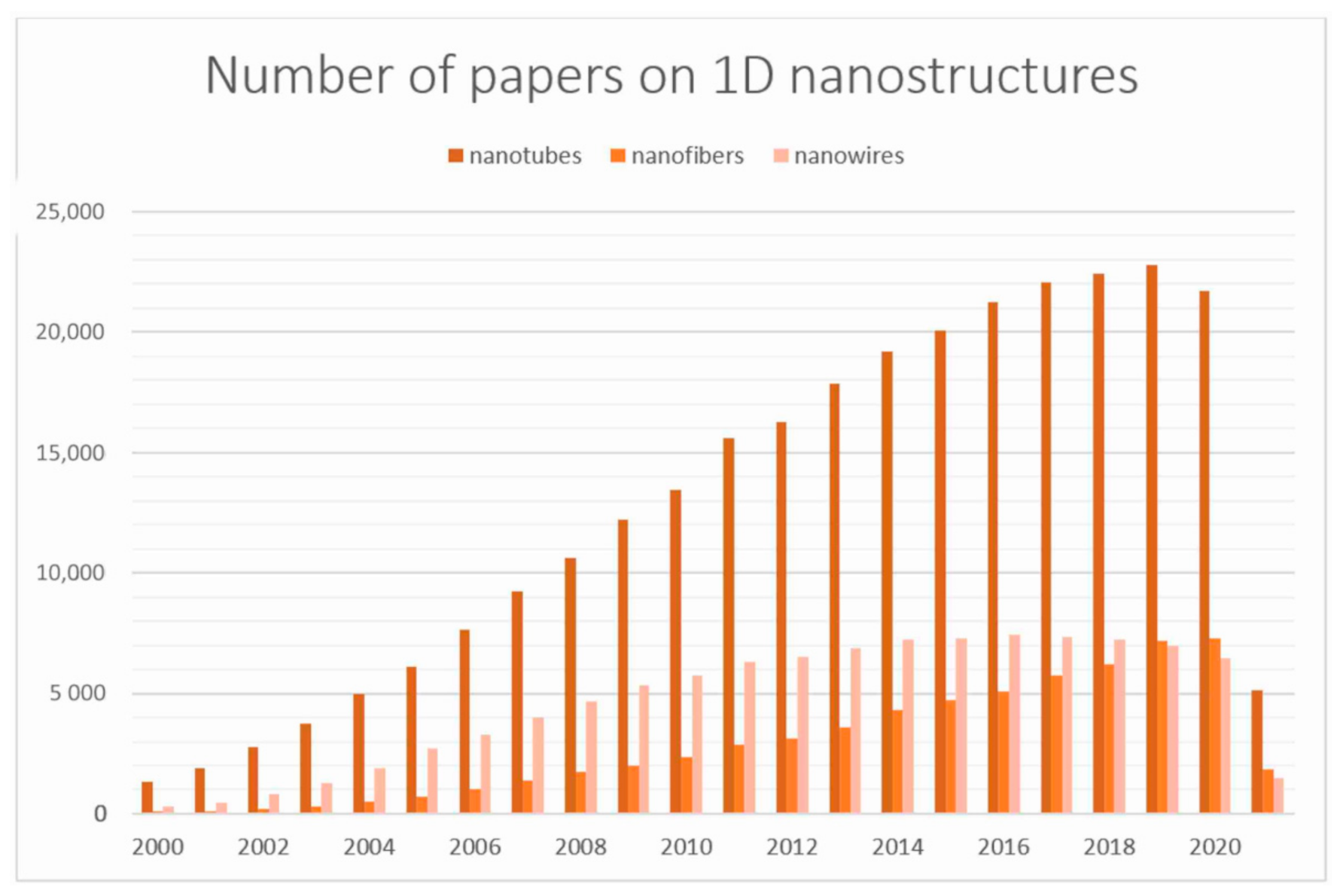
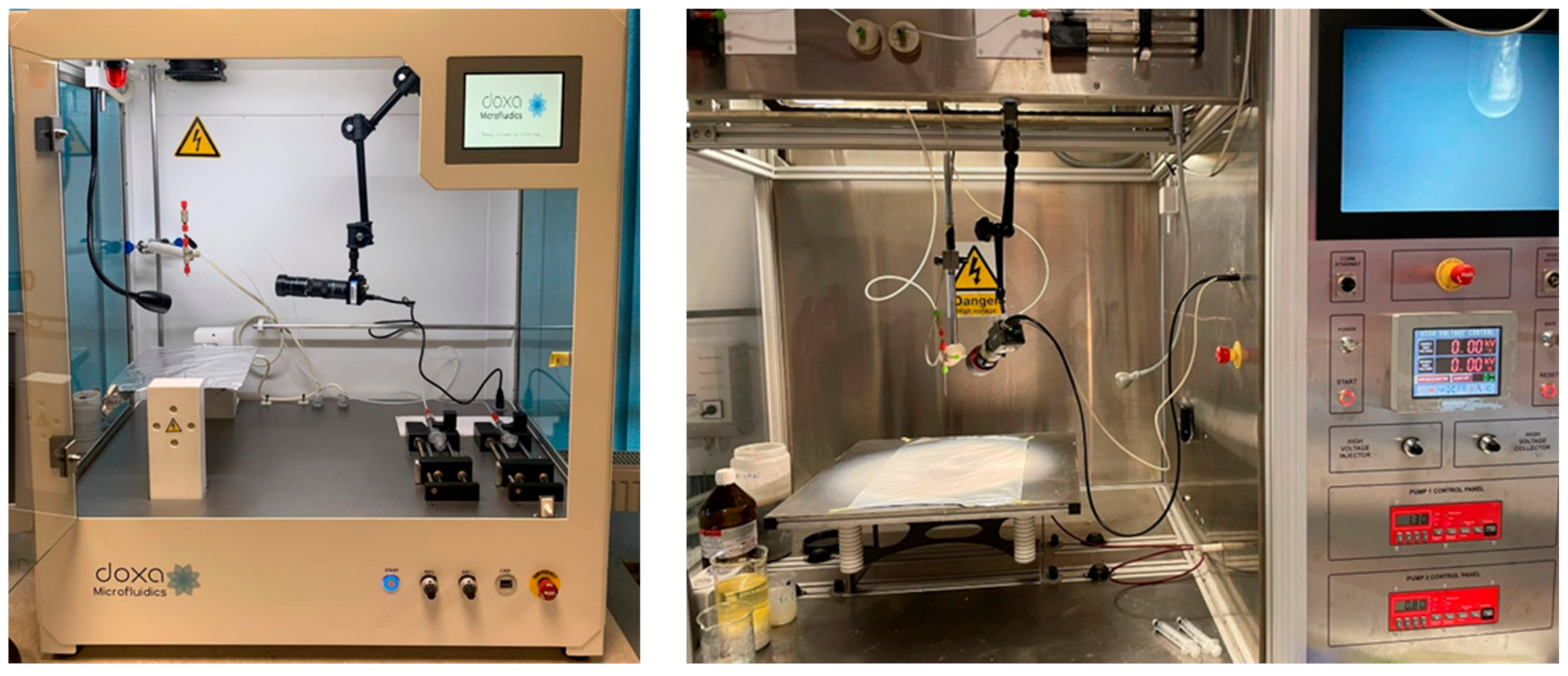
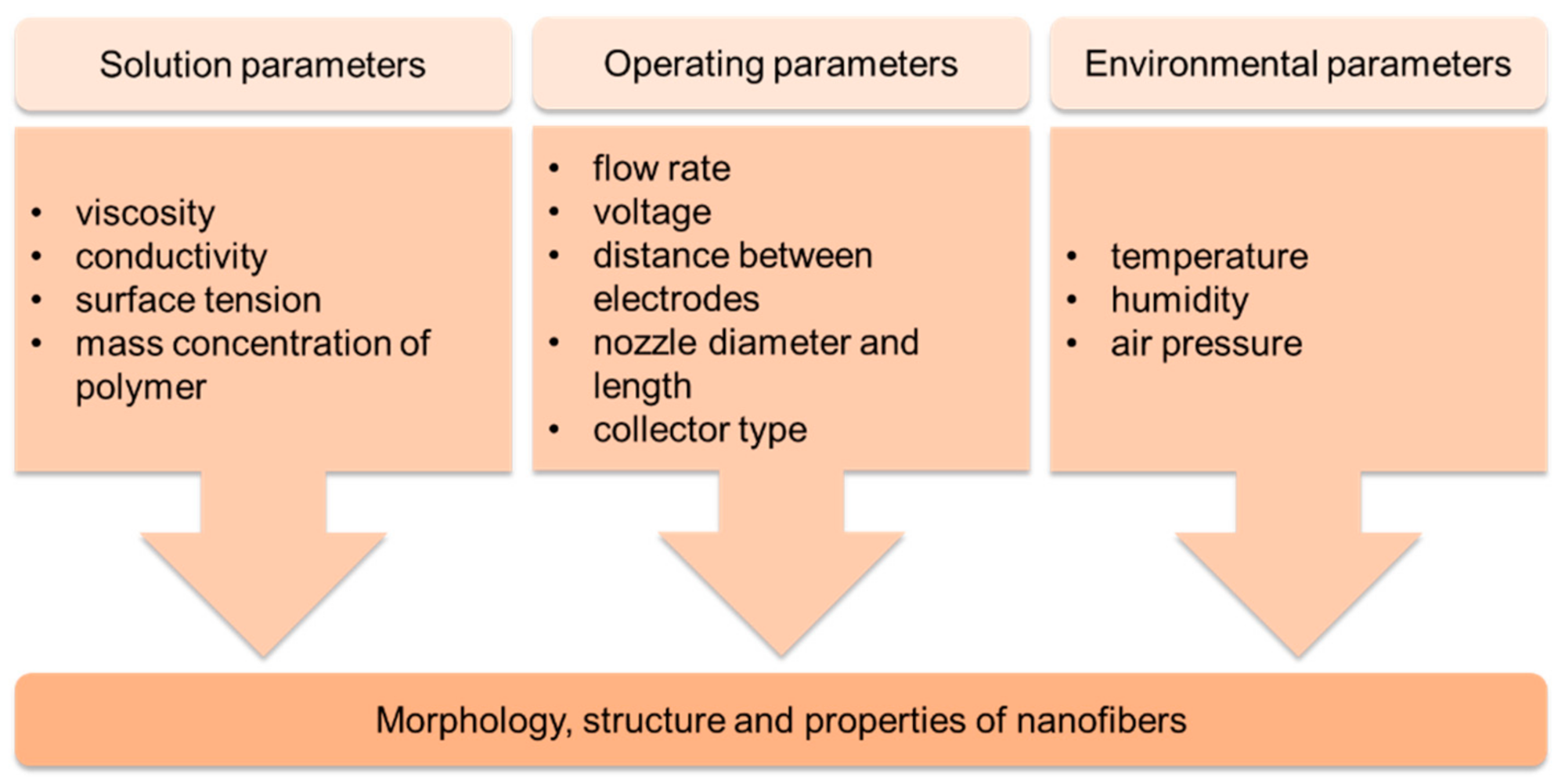
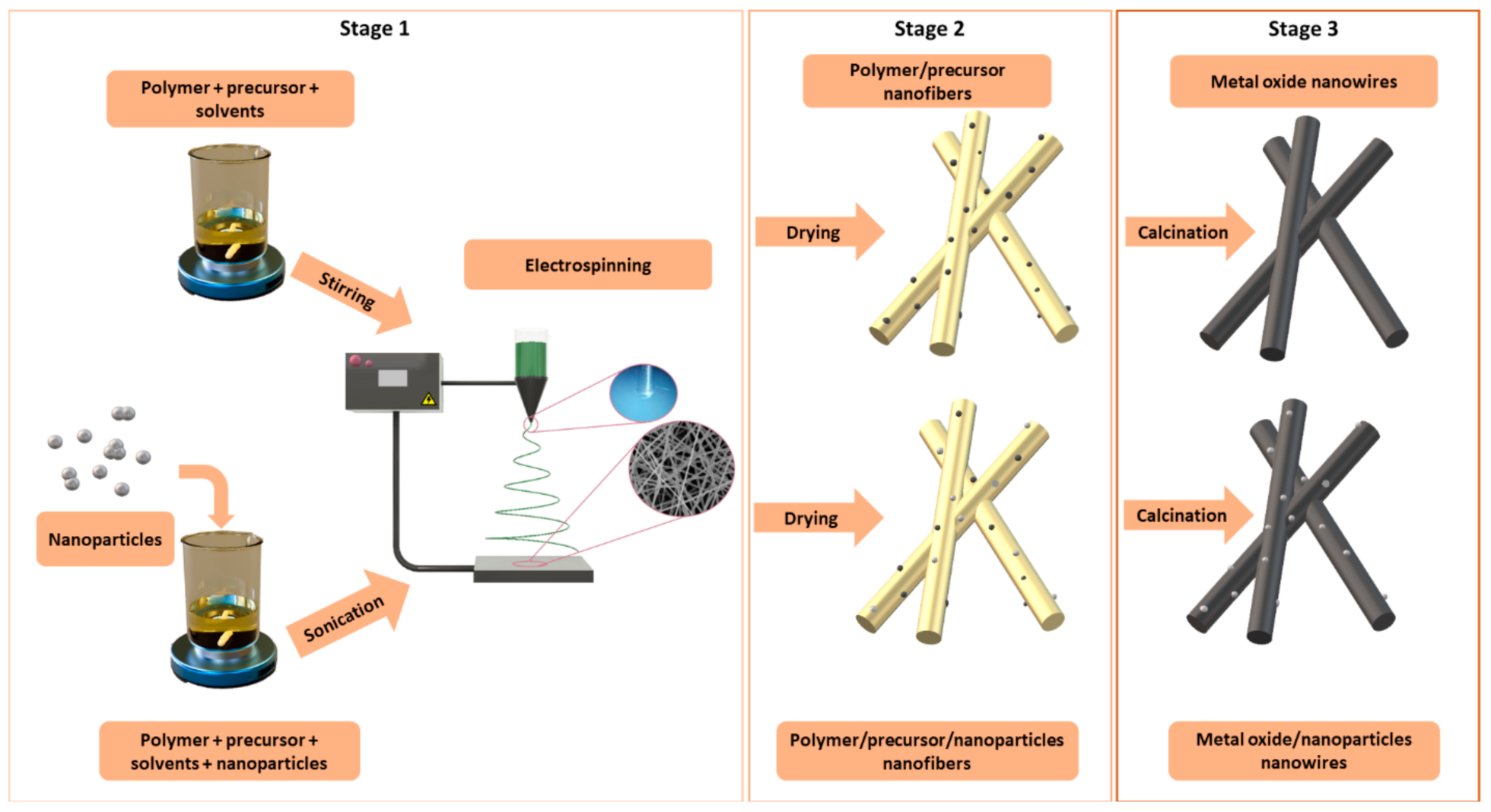
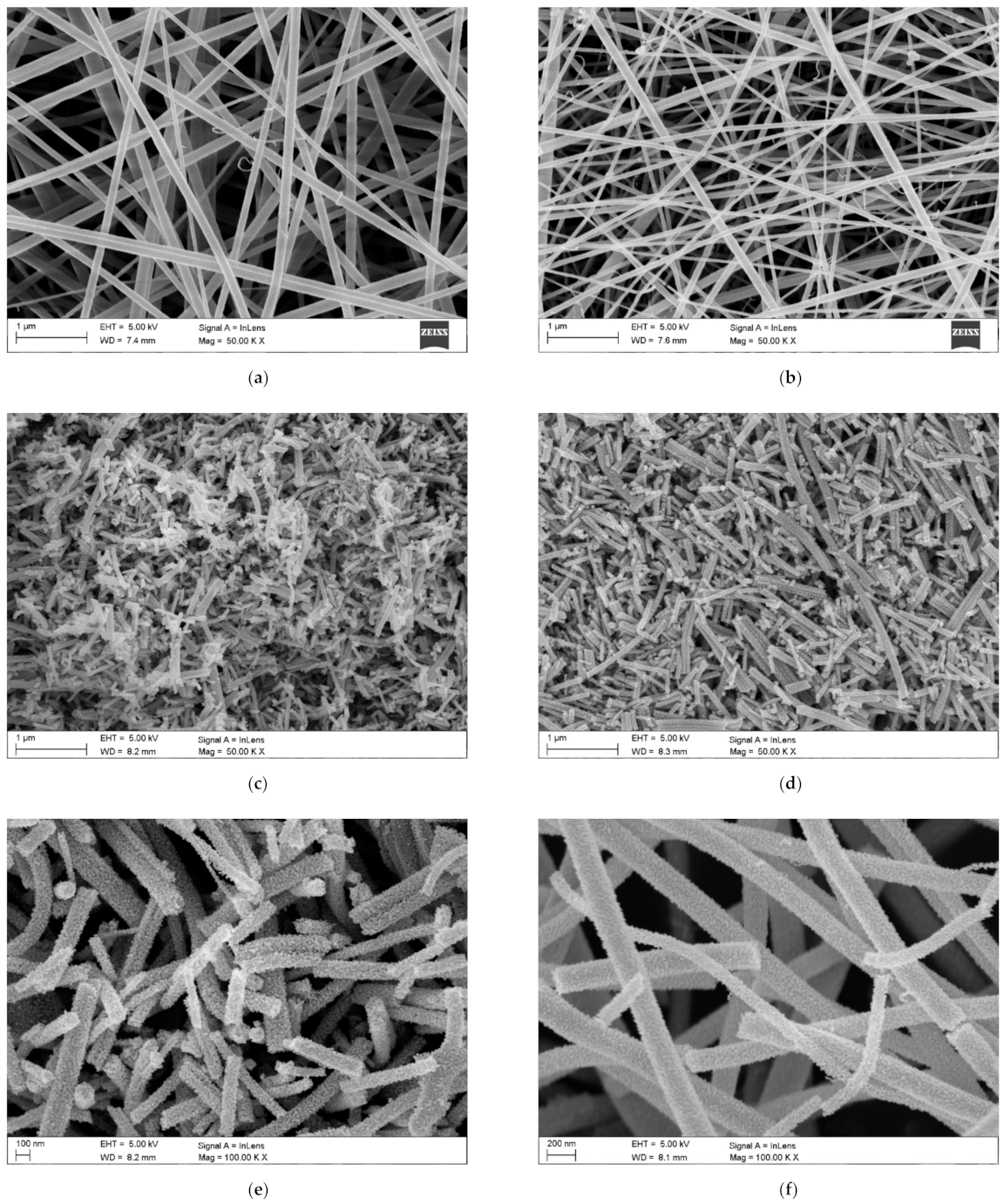
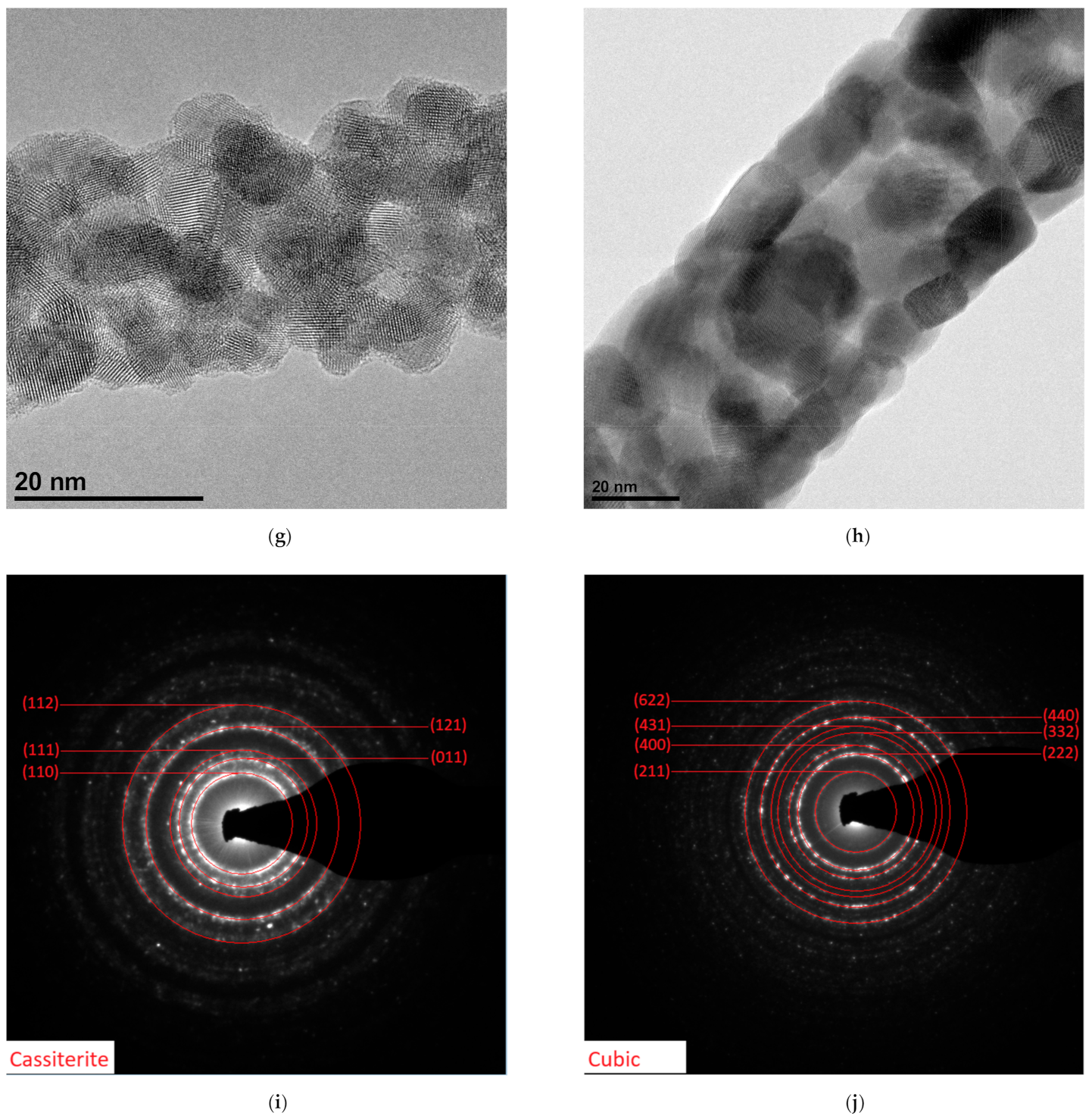
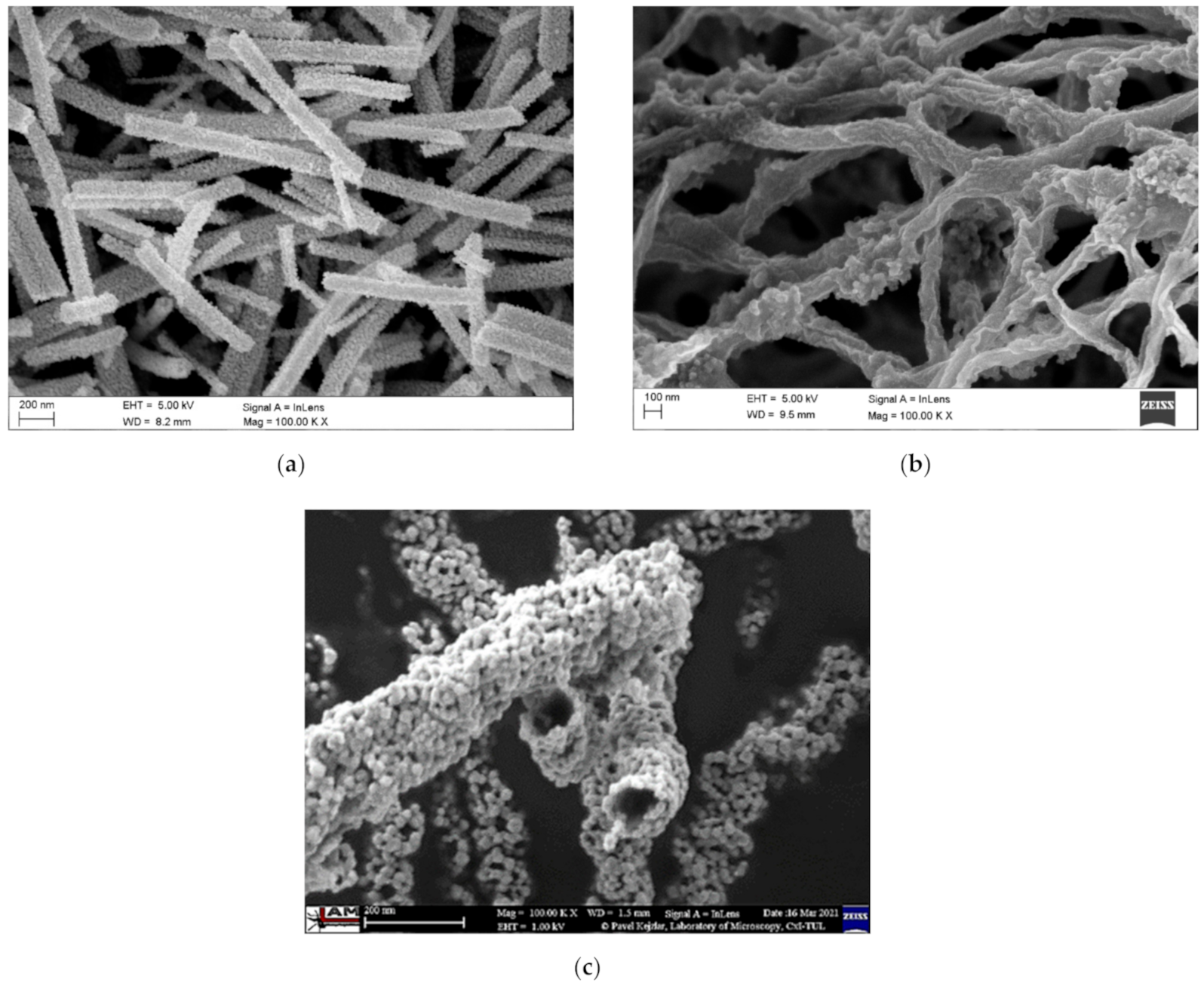
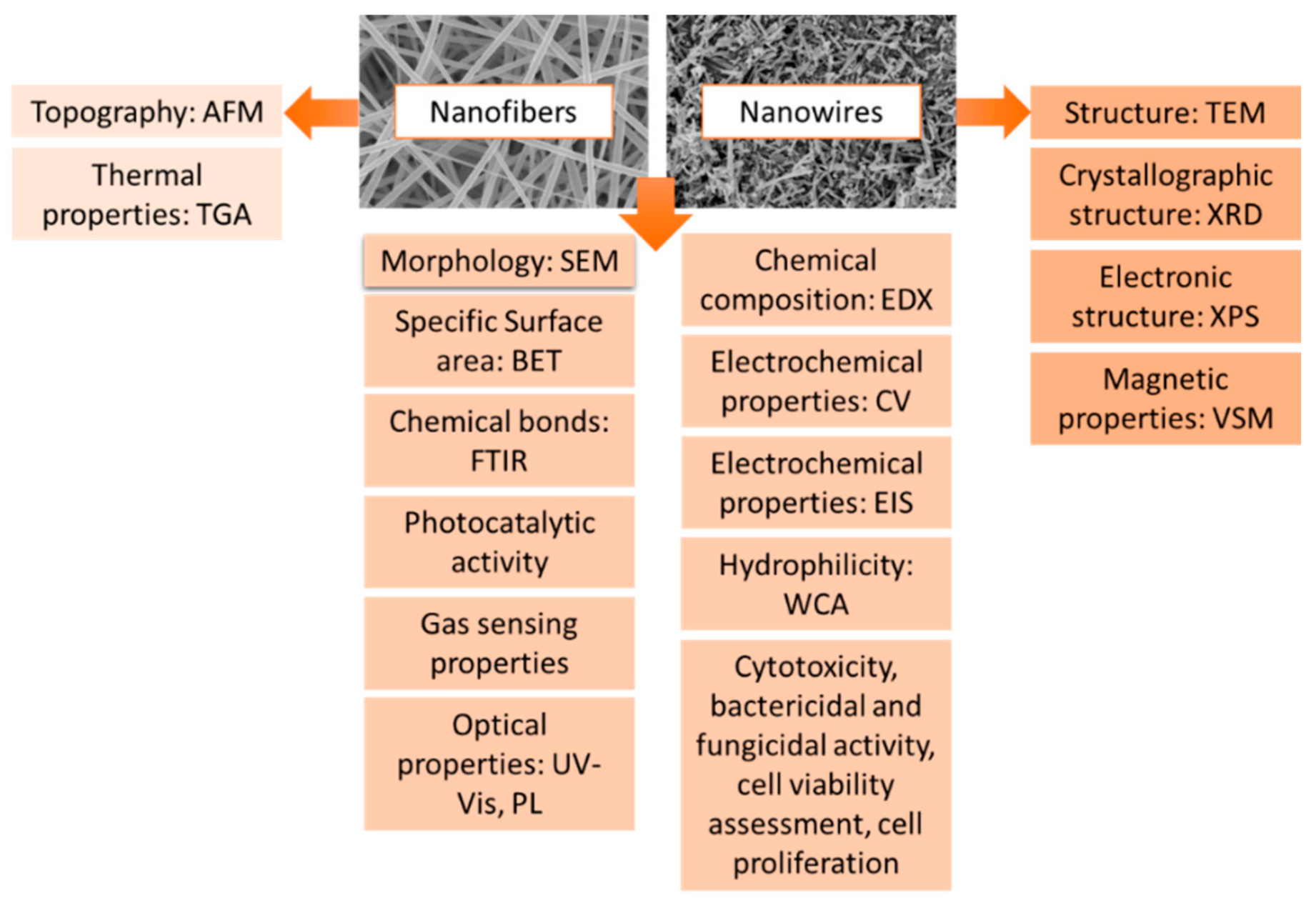
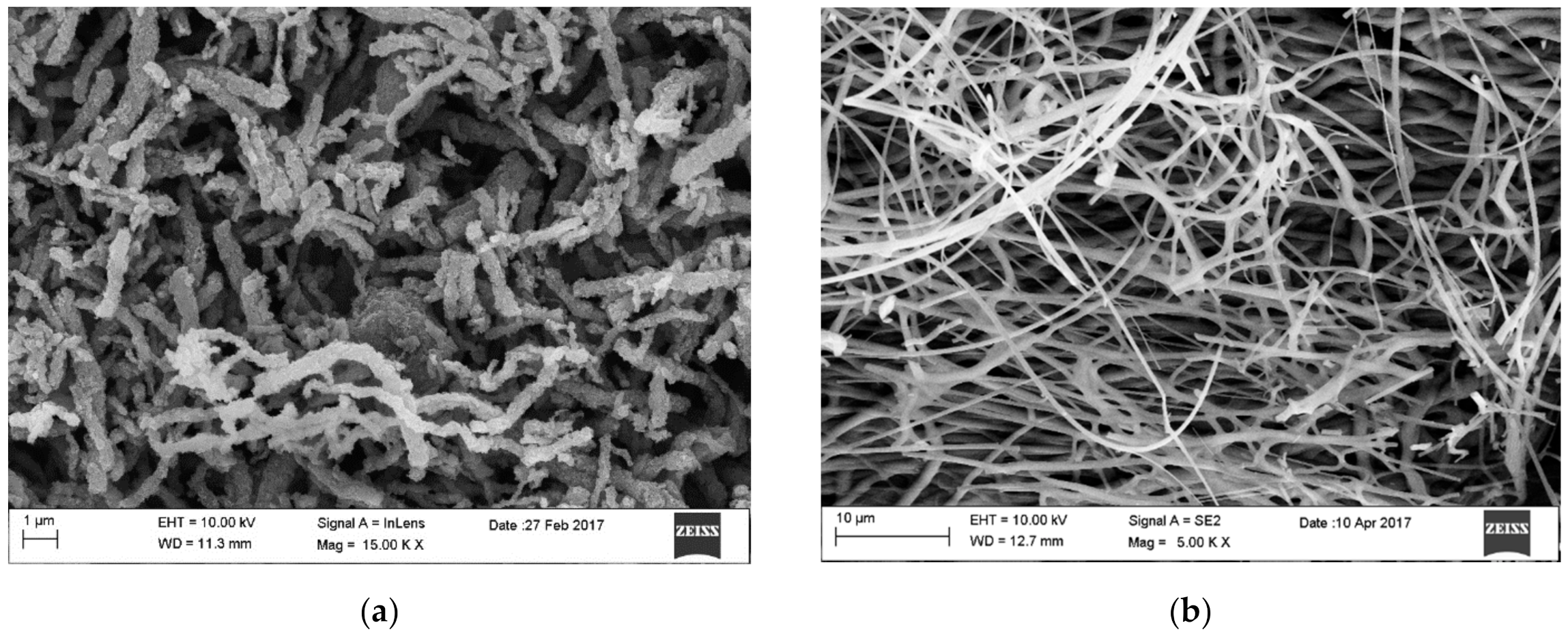
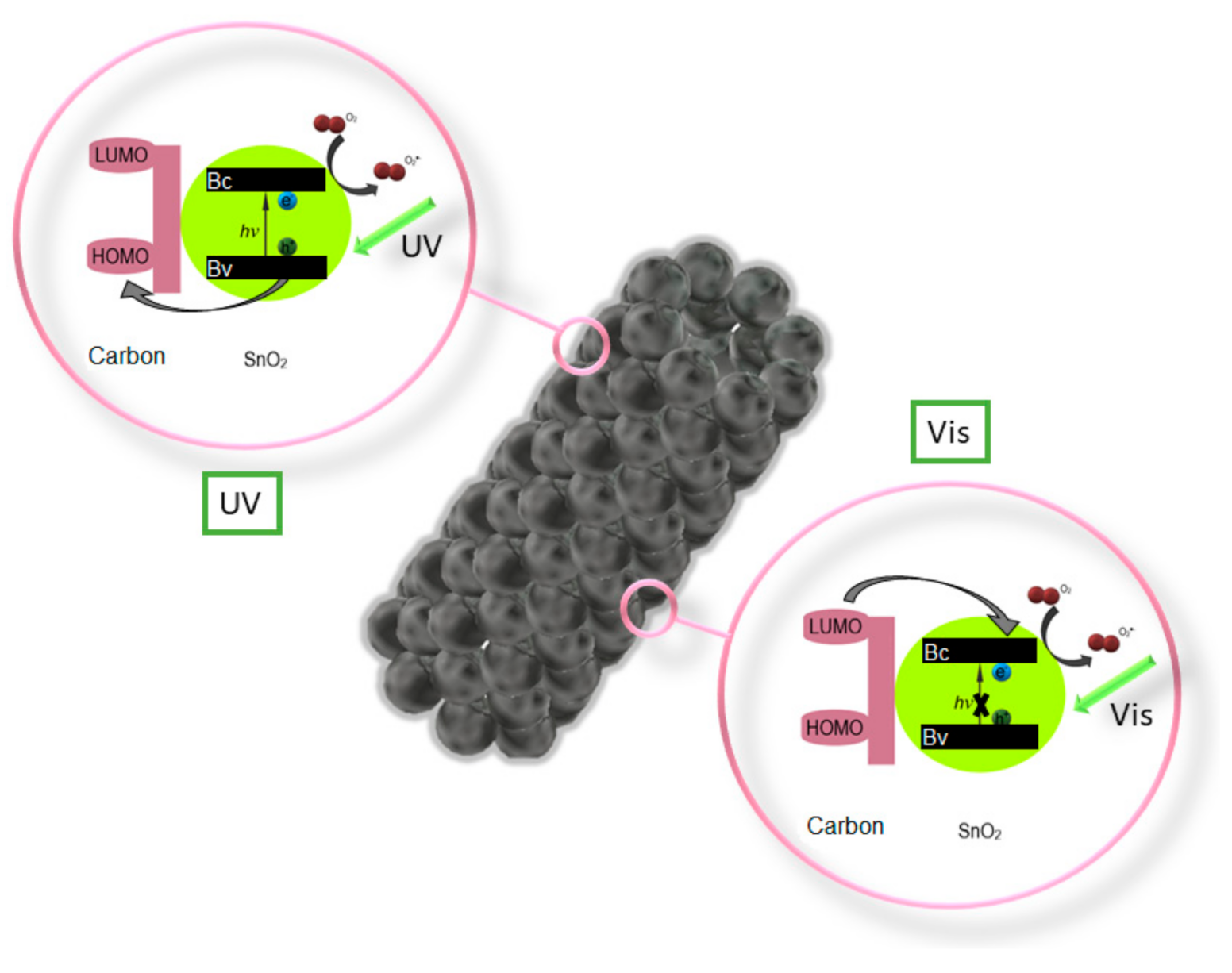
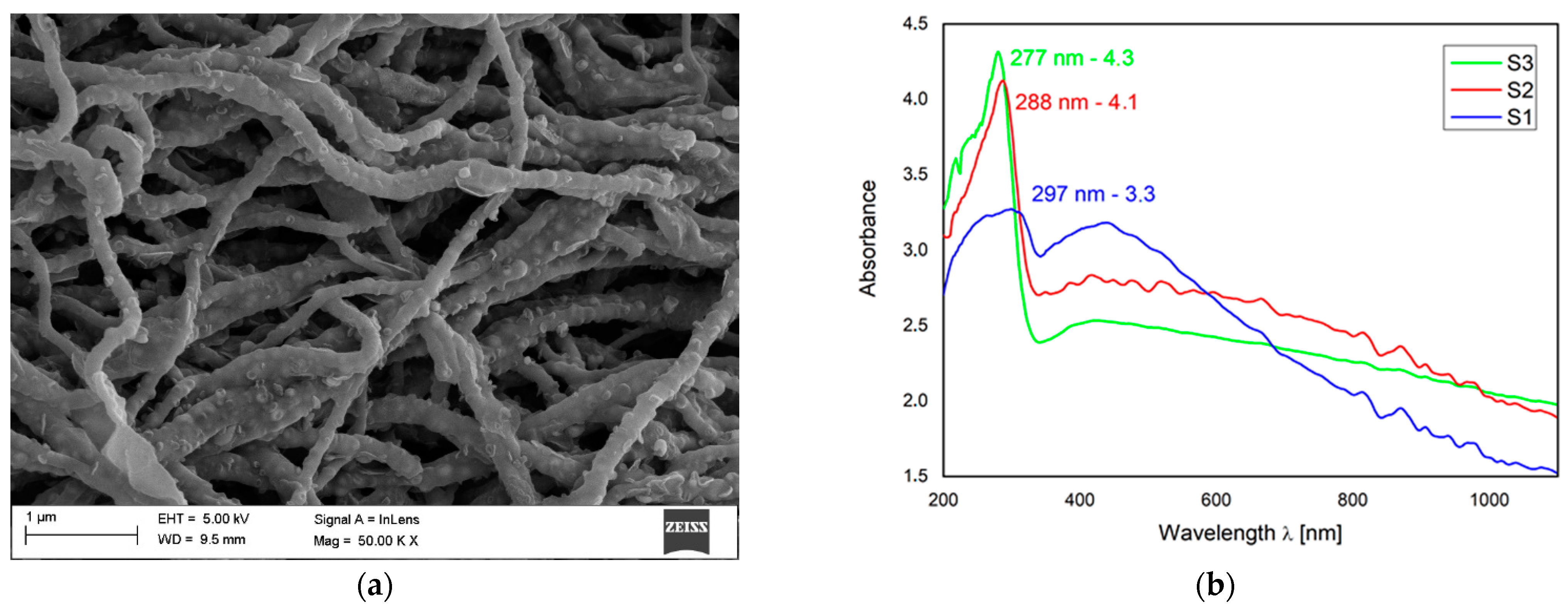
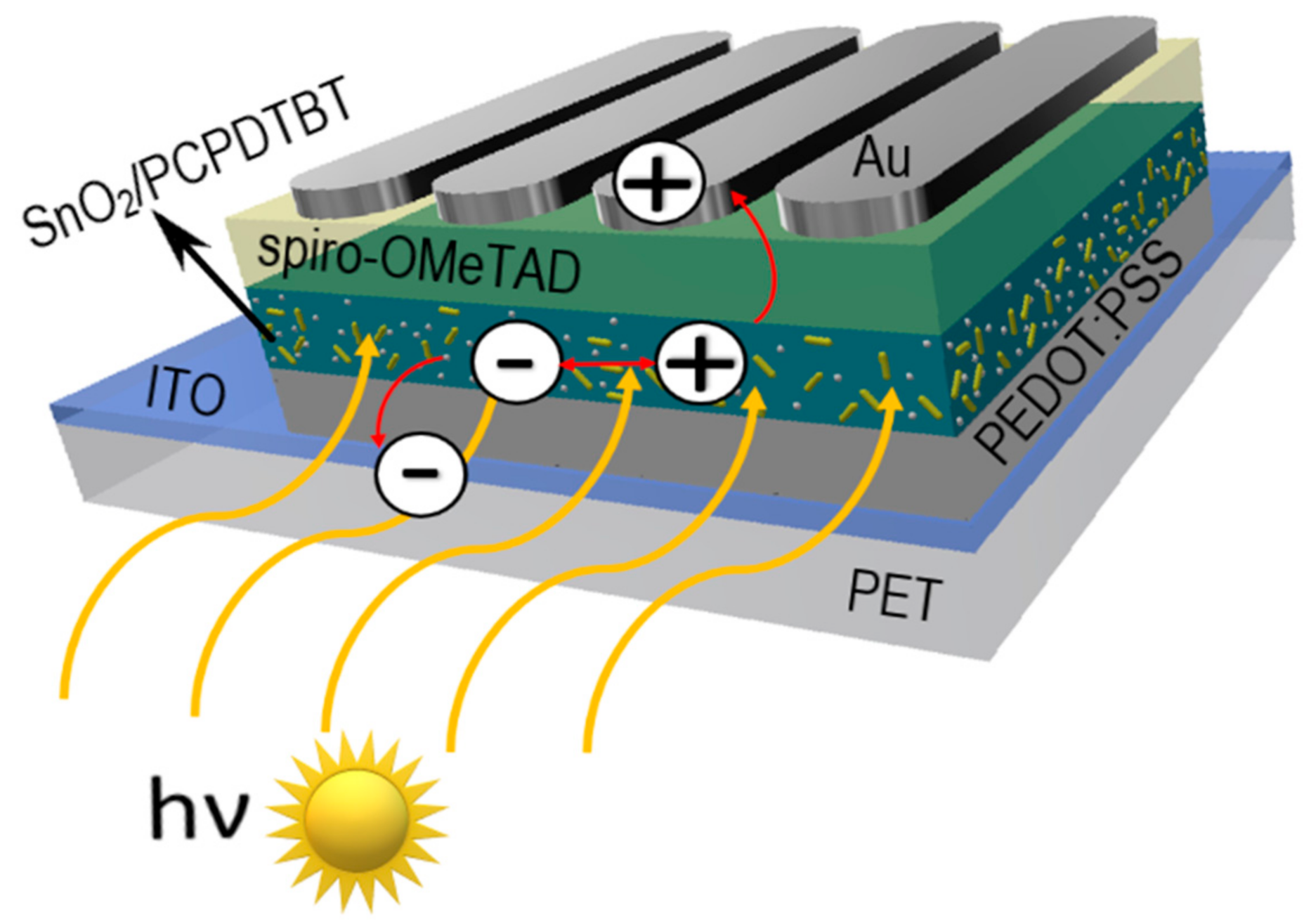
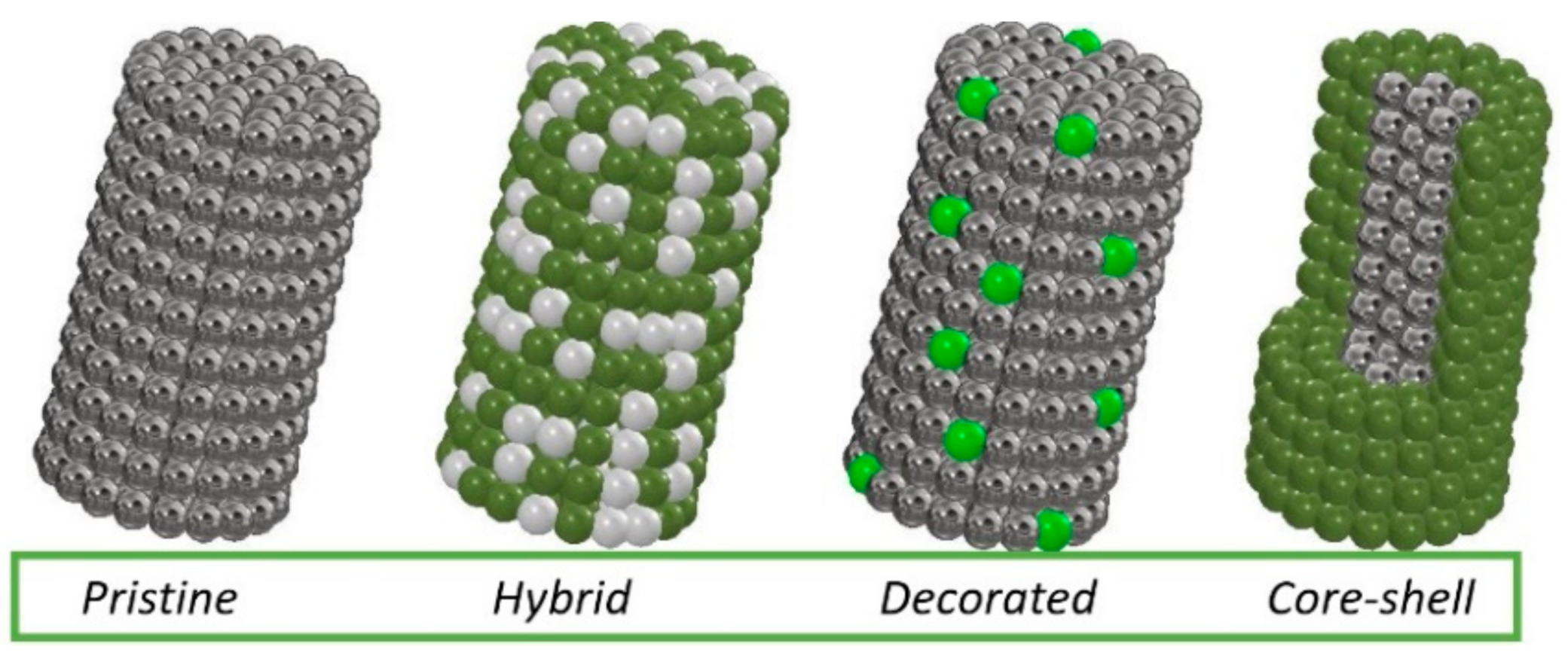
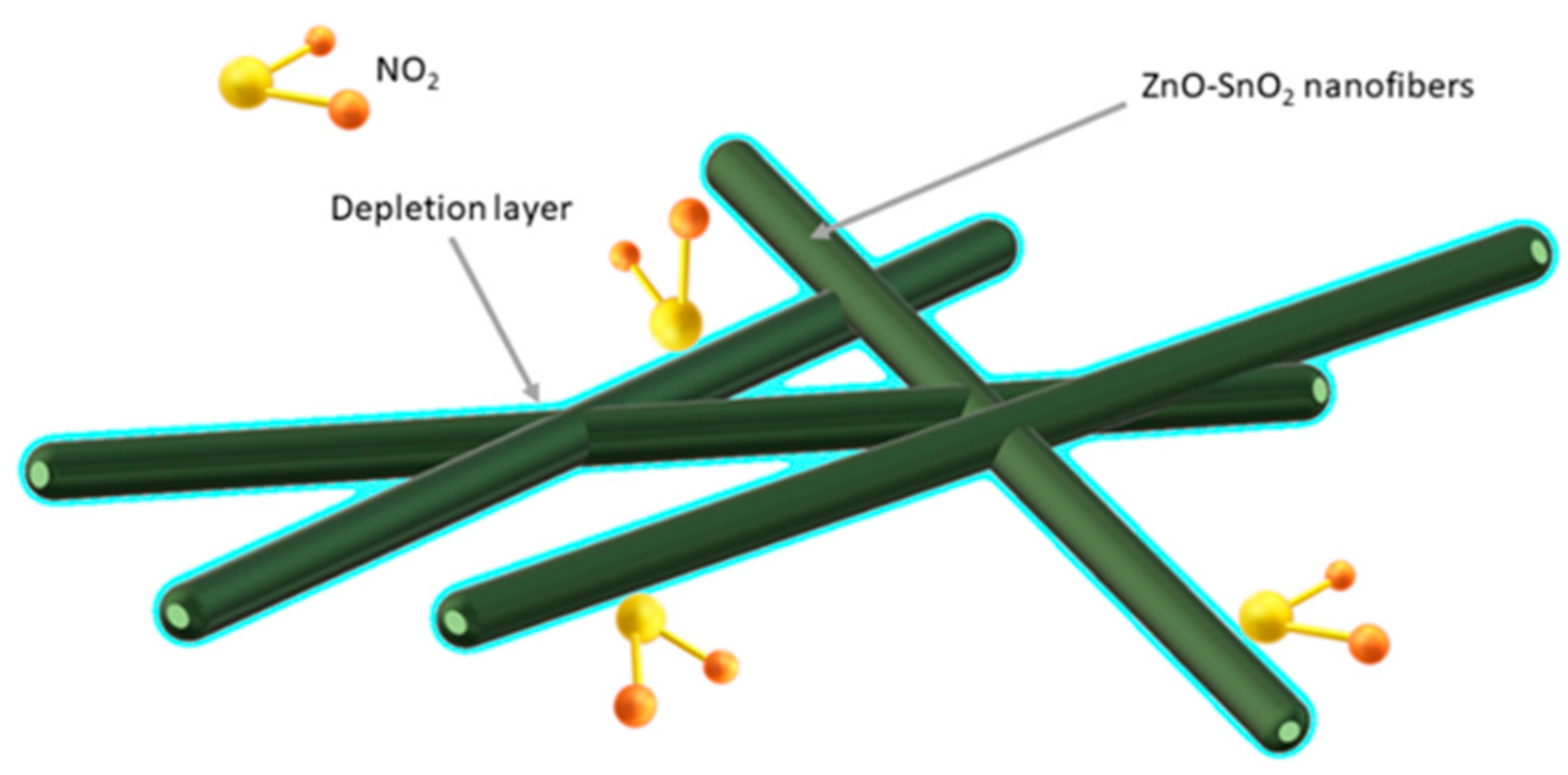
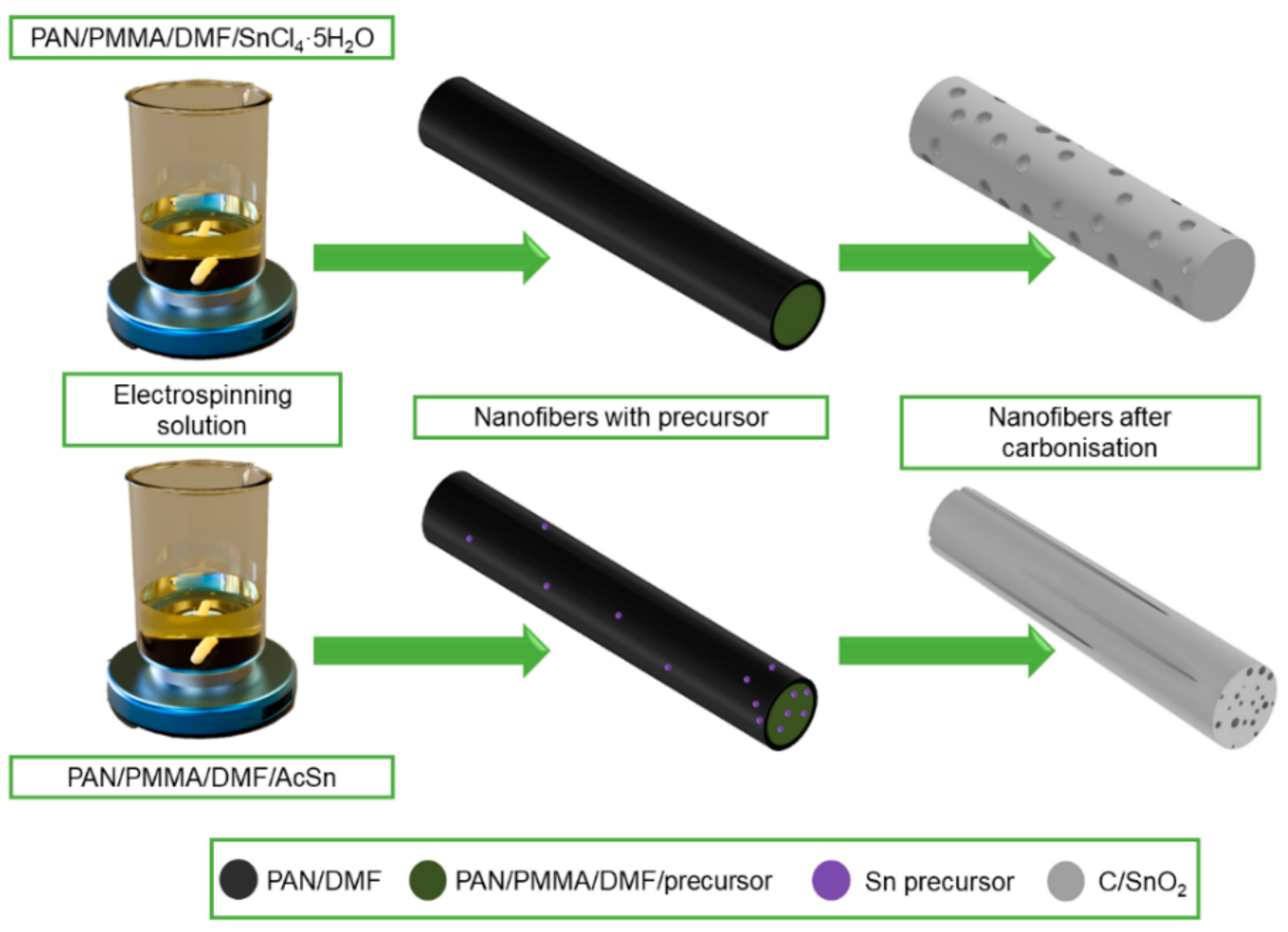
| Material | Polymer | Precursor | Calcination Temperature | Ref. |
|---|---|---|---|---|
| TiO2 | PVP | Ti(OCH(CH3)2)4 | 450 | [85] |
| TiO2 | PVP | C16H36O4Ti | 500 | [86] |
| ZnO | PVA | Zn(CH3CO2)2·2H2O | 400/500/600 | [65] * |
| ZnO | PVP | Zn(CH3CO2)2·2H2O | 350–600 | [87] |
| SiO2 | PVP | Si(OC2H5)4 | 600 | [22] |
| SiO2 | PVA | Si(OC2H5)4 | 600 | [88] |
| WO3 | PVA | (NH4)6H2W12O40H2O | 400/500/600/700 | [89] |
| WO3 | PVP | WCl6 | 450–600 | [90] |
| CuO | PVP | Cu(CH3COO)2 | 500/600/700/800/900/1000 | [91] * |
| CuO | PVP | Cu(NO3)2∙3H2O | - | [92] |
| Fe2O3 | PVA | Fe(NO3)3·9H2O | 800 | [93] |
| Fe2O3 | PVP | Fe(CH3COO)2 | 500/600/700/800/900/1000 | [94]* |
| SnO2 | PVA | SnCl2·2H2O | 300/500/700 | [95] |
| SnO2 | PVP | SnCl2·2H2O | 500/600 | In press * |
| Bi2O3 | PAN | Bi(NO3)3 | 500/550/600 | [96] |
| Bi2O3 | PVP | Bi (NO3)3.5H2O | 450 | [97] |
| In2O3 | PVP | In(NO3)3·4.5H2O | 600 | [18] |
| In2O3 | PVP | In(NO3)3·xH2O | 600 | [98] |
| MOS | TiO2 | ZnO | SiO2 | SnO2 | Bi2O3 | In2O3 |
|---|---|---|---|---|---|---|
| Direct band gap [eV] | 2.91–2.94 | 3.32–3.36 | 3.93–3.97 | 3.30–3.58 | 2.48–2.72 | 2.92–3.34 |
| Ref. | [86] | [65] | [11] | [108] | [109] | [23,110] |
| Material | Calcination Temperature [°C] | Max. Absorbance | Wavelength [nm] | Eg [eV] |
|---|---|---|---|---|
| TiO2 nanowires | 400 | 2.42 | 248 | 3.73 |
| 500 | 2.34 | 3.83 | ||
| 600 | 2.26 | 3.88 | ||
| ZnO nanowires | 400 | 2.94 | 346 | 3.36 |
| 500 | 3.38 | 3.34 | ||
| 600 | 3.43 | 3.32 |
| Parameter | SnO2 Nanowires | ||
|---|---|---|---|
| Type of Spinning Solutions | |||
| Type 1 | Type 2 | Type 1 | |
| refractive index (n) | 1.51 | 1.52 | 1.51 |
| complex dielectric permeability (ε) | 2.28 | 2.30 | 2.28 |
| Energy band gap (Eg) | 3.3 | 3.8 | 3.9 |
Publisher’s Note: MDPI stays neutral with regard to jurisdictional claims in published maps and institutional affiliations. |
© 2021 by the authors. Licensee MDPI, Basel, Switzerland. This article is an open access article distributed under the terms and conditions of the Creative Commons Attribution (CC BY) license (https://creativecommons.org/licenses/by/4.0/).
Share and Cite
Smok, W.; Tański, T. A Short Review on Various Engineering Applications of Electrospun One-Dimensional Metal Oxides. Materials 2021, 14, 5139. https://doi.org/10.3390/ma14185139
Smok W, Tański T. A Short Review on Various Engineering Applications of Electrospun One-Dimensional Metal Oxides. Materials. 2021; 14(18):5139. https://doi.org/10.3390/ma14185139
Chicago/Turabian StyleSmok, Weronika, and Tomasz Tański. 2021. "A Short Review on Various Engineering Applications of Electrospun One-Dimensional Metal Oxides" Materials 14, no. 18: 5139. https://doi.org/10.3390/ma14185139






